Text
Unit 6b: Applying Biological Principles
Applying Biological Principles
It's important to be able to relate biological principles to a case study and discuss the economical, environmental & ethical issues involved.
Ecology
What is the natural habitat of the species?
What conditions exist in that habitat?
Do the organisms have any special relationships?
Managing Growth
What habitat is used?
How are nutrients supplied?
How is competition minimized?
Do other species affect growth?
What conditions are controlled for optimal growth?
How are organisms kept free of parasites & disease?
How is technology used to ensure optimal growth?
Managing Reproduction
What is the life cycle of the species?
How is reproduction managed?
Are artificial techniques used?
How are new organisms cared for?
Breeding
What breed or variety is used?
Where was it developed?
What technology is used in breeding?
Is artificial selection used in farming?
Economic Return
What products are marketed?
Are the products exported?
What costs are involved?
What return is generated?
Environmental Issues
How does the operation impact on the environment?
Is permission required to use environmental resources?
How are wastes & pollution managed?
Ethical Issues with Animals
Does the farming operation cause distress to animals?
Are the animals killed in a humane way?
-
Source: Science: NCEA Level 1 (New Zealand Pathfinder series).
#science#biology#zoology#botany#farming#agriculture#crop raising#livestock farming#ecology#environmentalism#ethics#biological principles
5 notes
·
View notes
Text
Unit 6a: Managing Plants and Animals
Plant & Animal Growth
In order to grow, organisms require:
nutrients (chemicals)
energy
These resources come from:
the environment
food
Food is made up of complex molecules:
carbohydrates (sugar, starch & cellulose)
lipids (fat & oil)
proteins
The food molecules are used:
to build new tissue
as an energy source for activities
Plants & animals differ greatly in how they obtain nutrients & energy.
Plants can produce food out of simple molecules & ions from their environment. But animals cannot do this – they must consume other organisms in order to obtain food.
Because of this:
plants are producers
animals are consumers
-
Factors Affecting Plant Growth
Plants must make food in order to grow.
Plants produce food in their leaves via the process of photosynthesis.
They use sunlight to transform CO2 (from the air) and water (from the soil) into sugar.
Next, the sugar is changed into starch, cellulose & proteins – the minerals that the plant needs.
Environmental factors that affect photosynthesis (and therefore affect plant growth):
sunlight intensity
shading
CO2 levels in the air
water, mineral & pH levels in the soil
air & soil temperature
Photosynthesis can be slowed down by water loss. These factors can increase water loss:
wind
humidity
air temperature
Plant growth in general is also affected by:
competition (see below)
grazing
parasitism
disease
Competition can be for:
space
light
water
minerals
Competition is most intense between plants of the same species.
-
Factors Affecting Animal Growth
Animals must find food in order to grow.
Animals that eat plant tissues are herbivores, while those that eat animals are carnivores.
Food must be digested so that the molecules can be used for energy & growth.
Environmental factors that affect animal growth:
abundance & quality of food
water supply
temperature of the surroundings
shelter
space
level of dissolved oxygen in water (for aquatic animals)
Animal growth can also be affected by:
competition (see below)
parasitism
disease
Resource competition can be over:
territory
living space
food
mates
-
Optimal Growth
Members of a species can tolerate a range of conditions for each environmental factor. But if a factor goes beyond certain limits, then it becomes a limiting factor on growth.
For each environmental factor, there is an optimal range. Within the optimal range, the species will grow at the fastest rate.
For optimal growth, all environmental factors need to be within their optimal range.
-
Managing Organisms
Plants & animals are often managed for our benefit. This includes growing crops and raising herds for food and other products (such as fibres).
Traditional plant crops include cereals, fruits, vegetables and pine trees. Newer crops include avocadoes, olives and wine grapes.
The range of potential crops has been extended by glasshouses and hydroponics (soil-free methods).
Traditional farming includes raising sheep, cattle, pigs and poultry for:
meat
dairy
eggs
wool
Farms of these have been more recently established:
deer
alpacas
ostriches
salmon
mussels
paua
For successful management, it is essential to:
provide resources in sufficient quantities
control environmental factors so that optimal growth occurs
minimize competition between individuals
protect organisms from parasites & pathogens
If a plant crop involves reproduction, then you may need to provide pollinating agents to ensure that seeds or fruit develop.
Most types of animal farming depend on producing the maximum number of offspring. This means that provisions must be made for the mating & care of pregnant animals. Young animals may be hand-reared to ensure maximum survival and optimal growth.
-
Selective Breeding
All managed plants & animals have been selectively bred by humans, over many generations. Organisms with desirable traits have been selected and bred from, until all offspring show the desired traits.
Humans have managed to create new plant varieties and animal breeds, by:
selective breeding (artificial selection)
hybridization (crossing organisms from different strains)
using mutant organisms
Genetic engineering (also called genetic modification) allows a single gene to be transferred from one species to another.
Cloning is the artificial production of individual organisms that are genetically identical. Plants are cloned from cuttings.
Cloning mammals will allow breeders to rapidly develop new herds.
-
Source: Science: NCEA Level 1 (New Zealand Pathfinder series).
#science#biology#zoology#botany#farming#agriculture#crop raising#livestock farming#chemistry#ecology#photosynthesis#reproduction#selective breeding#genetic engineering#cloning
4 notes
·
View notes
Text
Unit 5b: Punnet Squares and Pedigree Charts
Predicting Phenotype Ratio of Monohybrid Crosses
With a monohybrid cross, you study how a single gene is inherited.
A monohybrid cross is the study of the inheritance of one characteristic. It's a cross between two organisms with different variations of one genetic “locus of interest”.
By using a punnet square, the genotypes of offspring can be identified, and the frequency of expected phenotypes can be determined.
A punnet square is a square diagram that's used to predict the genotypes of a particular cross or breeding experiment. This approach was designed in 1905 by Reginald C. Punnett.
-
How to Do a Punnet Square
1. Write down the phenotype & genotype of each parent. In this example, both parents are tongue-rollers, each with an Rr genotype. Therefore:
maternal phenotype = roller
maternal genotype = Rr
paternal phenotype = roller
paternal genotype = Rr
2. Identify the type of gametes that will be produced by each parent. In this example, both parents will produce R and r gametes in equal numbers.
3. On the left-hand side of the square, write the genotypes of each sperm. Do the same for each egg above the square.
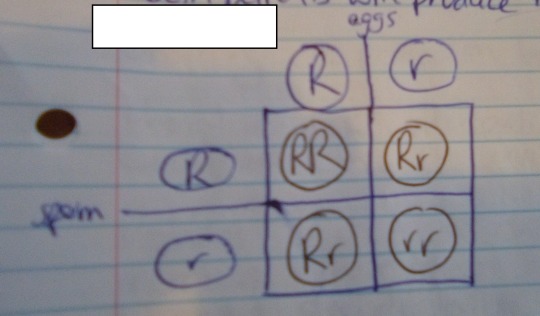
4. In each box, write the genotype of the zygote formed if the sperm on the left met the egg from above.
5. Identify the distinct genotypes and the chances of getting each one:
RR 25%
Rr 50%
rr 25%
The genotype ratio here is 1:2:1.
The phenotype ratio is 3:1 (75% rollers and 25% non-rollers).
(The genotypes Rr and rR are the same.)
-
Using a Pedigree Chart to Identify Genotypes
A pedigree chart is used to identify the genotypes of parents or their offspring.
a circle represents a female
a square represents a male
a horizontal line joining male & female shows reproduction
offspring are placed in branches under the parents
phenotypes are written outside the circles & squares
genotypes are written inside the circles & squares
The chart gives the natural hair shape of family members. There are two basic phenotypes: curly/wavy hair and straight hair.
1. Decide on the symbol for the alleles.
dominant allele for curly hair is C
recessive allele for straight hair is c
2. Two recessive alleles are needed for the related phenotype to be expressed. Locate all straight-haired individuals & write in their cc genotypes (blue pen).
3. Offspring that have straight hair must have inherited two c alleles. Check that their parents have at least one c in their genotype, and if not, add one (purple pen).
4. A parent in which the recessive gene is expressed passes on a c allele to each of their offspring (because their genotype has to be cc). Make sure each of the offspring have a c in their genotype (red pen).
5. The genotypes of some individuals can now be completed so that their phenotype can be stated. For example, if an individual has a c allele and curly hair, the other allele must be C, so their genotype is Cc (black pen).

6. For some individuals showing the dominant trait, you still might now know if they're CC or Cc, so just write “C?” However, this is not the case in this example.
-
Source: Science: NCEA Level 1 (New Zealand Pathfinder series).
#science#biology#human biology#genetics#applied genetics#reproduction#dna#genes#gametes#meiosis#alleles#dominant alleles#recessive alleles#monohybrid cross#punnet square#pedigree chart
4 notes
·
View notes
Text
Unit 5a: Applied Genetics
Phenotype & Genotype
A gamete has one gene for each trait.
At fertilization, an egg fuses with a sperm to create a zygote. The new organism has two genes for each trait – one from each parent.
The phenotype is the set of observable traits (or characteristics) of an organism. “Phenotype” also refers to the appearance of a single trait.
For example, tongue-rolling is a trait. There are two possible phenotypes – rolling and non-rolling.
The genotype is the organism's complete set of genetic material; it is the genetic contribution to the phenotype. “Genotype” can also refer to the alleles/variants that an individual carries in a particular gene or genetic location.
Some genes have alternative forms called alleles. For tongue-rolling, one allele codes for the ability to roll your tongue, and one allele codes for non-rolling.
If both alleles of the genotype are the same, then the resulting phenotype is obvious. 2 roller alleles mean that you can roll your tongue; 2 non-roller alleles mean that you cannot.
When the two alleles are the same (as in the example above), then the person has a homozygous genotype. But if the two alleles are different, then the person has a heterogenous genotype.
Usually, only one of the two different alleles will be expressed in the phenotype. If the person has a roller and non-roller allele, then only the first allele is expressed – they can roll their tongue.
-
Dominant & Recessive Alleles
The allele that is always expressed is called the dominant allele. The allele that may not be expressed is called the recessive allele.
The dominant form of a gene is written as a capital letter, and the recessive form is written as the same letter in lower case (eg R and r).
If the person has two roller alleles, it's written RR, and they have a homozygous dominant genotype.
If the person has two non-roller alleles, it's written “rr”, and they have a homozygous recessive genotype.
For a recessive allele to be expressed, the organism must have two of them (eg “rr”).
A dominant gene will be expressed whether you have one or two of them (eg RR and Rr).
-
Chance in Genetics
In ovaries (female) and testicles (male), body cells undergo meiosis in order to produce large numbers of gametes.
The body cell that undergoes meiosis has two alleles for each trait (like all other body cells). But during meiosis, it duplicates only once and divides twice. Each of the resulting gametes only gets one of each allele pair.
If the parent organism is homozygous (RR) for this allele pair, then all the gametes will have the same allele (R).
But if the parent organism is heterozygous (Rr), then half of the gametes will have the R allele, and the other half will have the r allele.
So for this second examle, at fertilization, there's a 50% chance that the successful sperm has the dominant allele R as opposed to the recessive allele r.
-
Source: Science: NCEA Level 1 (New Zealand Pathfinder series).
#science#biology#human biology#genetics#applied genetics#reproduction#dna#genes#gametes#meiosis#alleles#dominant alleles#recessive alleles
3 notes
·
View notes
Text
Unit 4b: How Meiosis Works
During meiosis, one cell divides twice, thus producing four cells, each with ½ the number of chromosomes. Therefore, each gamete has only ½ the genetic information. This makes the gametes haploid (as opposed to diploid).
Meoisis can be divided into 9 stages. The first time that the cell divides is meiosis I, and the second time it divides is meiosis II.
Background
A pair of homologous chromosomes is a set of one maternal and one paternal chromosome. These two chromosomes pair up with each other inside the cell during fertilization.
The two homologous chromosomes have the same:
gene sequence
gene loci
chromosomal length
centromere location
(But they differ in alleles.)
Each maternal chromosome has a corresponding paternal chromosome, and they pair up during meiosis.
The sex chromosomes (the 23rd pair) are homologous in females (XX) but not in males (XY).
Non-homologous chromosomes are called heterologous chromosomes.
Here is the first homologous pair of chromosomes (called Chromosome 1):
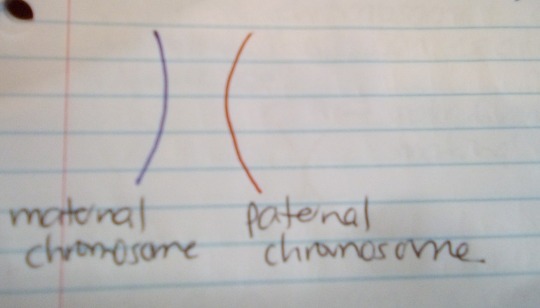
-
MEIOSIS I
Interphase
The DNA in the cell is copied (replicated). This results in 2 identical full sets of chromosomes.
Here are the original and duplicate of Chromosome 1 (1a is the original, and 1b is the duplicate):

There are two centrosomes outside of the nucleus, each containing a pair of centrioles. The centrosomes are essential for the process of cell division.
During interphase, microtubules extend from these centrosomes.
Prophase I
The copied chromosomes condense into X-shaped structures that can easily be seen under a microscope. The maternal chromosome pairs up with its duplicate, and the paternal chromosome pairs up with its duplicate.

Each chromosome is composed of 2 sister chromatids with identical genetic information.
The chromosomes now pair up so that the maternal pair & paternal pair from Chromosome 1 are together, etc.
The pairs of chromosomes may then exchange bits of DNA in a process called recombination or “crossing over”.
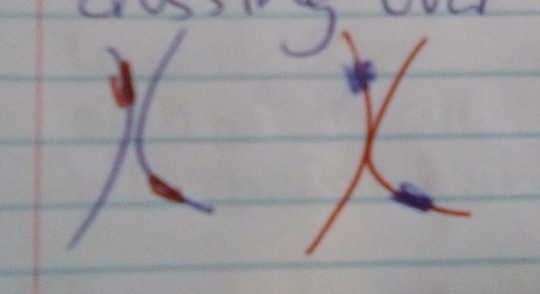
So now the 2 maternal chromosomes (in blue) are no longer completely identical, and neither are the 2 paternal chromosomes (in red).
At the end of this phase, the membrane around the cell nucleus dissolves away. This releases the chromosomes.
The meiotic spindle consists of microtubules and other proteins. It extends across the cell between the centrioles.
Metaphase I
The chromosome pairs line up next to each other along the equator (centre) of the cell.

The centrioles are now at opposite poles of the cell, with the meiotic spindles extending from them.
The fibres of the meiotic spindle attach to one chromosome of each pair.
Anaphase I
The meiotic spindle then pulls the chromosome pairs apart, so that the maternal pair is pulled to one pole of the cell, and the paternal pair is pulled to the opposite pole.

The sister chromatids (eg the maternal chromosome & its duplicate) stay together in meiosis I (but this is not the case later in meiosis II).
In short – the 2 maternal chromosomes (original & duplicate) have paired up, and have been separated from the equivalent paternal pair.
Telephase I & cytokinesis
The chromosomes complete their move to opposite poles of the cell.
A full set of chromosomes gathers together at each pole. BUT one set is made up of the original maternal chromosomes & their duplicates (with a bit of paternal DNA due to the crossing-over), and vice versa for the other set.
The single cell pinches in the middle to form two separate daughter cells. Each one has a full set of chromosomes within a nucleus. This process is called cytokinesis.
-
MEIOSIS II
Prophase I
Now there are 2 daughter cells, each with a full set of 23 pairs of chromatids.
One cell has the maternal pairs (with some paternal DNA), and the other has the paternal pairs (with some maternal DNA).

In each daughter cell, the chromosomes condense again into visible X-shaped structures (as seen above).
The membrane around the nucleus of each cell dissolves away. This releases the chromosomes, BUT they are still in their cells.
The centrioles duplicate, and the meiotic spindle forms again.
Metaphase II
In each cell, the chromosomes (i.e. pairs of sister chromatids) line up end-to-end along the cell equator).

In each cell, the centrioles are now at opposite poles.
Meiotic spindle fibres at each pole of the cell attach to each of the sister chromatids.

Anaphase II
The meiotic spindle pulls the sister chromatids APART, to opposite poles of the cell. In other words, the maternal pair are finally separated, and in the other cell, so are the paternal pair.
Now each separated chromatid is counted as an individual chromosome.
These separated chromatids complete their move to opposite poles of the cell. A full set of 23 individual chromosomes gathers at each pole.
A membrane forms around each set of chromosomes, which creates two new cell nuclei.
This is the last phase of meoisis, but another round of cytokinesis is still required.
Each daughter cell divides into two grand-daughter cells via cytokinesis. Now there are four grand-daughter cells from one original cell. Each is haploid, with 23 individual chromosomes.
In males, these four cells are all sperm cells.
In females, only one of these cells is an egg cell. The others are called polar bodies – small cells that don't develop into eggs.
-
Source: Science: NCEA Level 1 (New Zealand Pathfinder series).
4 notes
·
View notes
Text
Unit 4a: Chromosomes, Genes & DNA
The Zygote
Life begins as a single-celled zygote, formed when a sperm fertilizes an egg.
The zygote's nucleus contains many chromosomes, and each chromosome consists of thousands of genes.
The total collection of genes in the zygote is the organism's genome. The genome specifies what species the organism will be, as well as its particular traits.
-
Chromosomes
Chromosomes are long, thin, thread-like structures. They can coil up tightly into short, fat shapes. In this state, chromosomes are visible under the microscope as cells divide.

Human chromosomes under a microscope.
All members of the same species have the same number of chromosomes at the zygote stage, and it's always an even number. Humans have 46, chimps have 48, and horses have 64.
The chromosomes in a zygote may vary by size and shape, but they can be arranged into matching pairs (23 pairs for a human zygote, etc).
These matching pairs are called homologous chromosomes. One of each pair comes from the egg, and the other from the sperm.
Each human gamete (egg or sperm) has only 23 individual chromosomes, not 23 pairs of 46 in total. You usually inherit 2 genes for each trait – one gene from each parent.
These 2 genes for a particular trait will be found on the same place on each chromosome of the pair.
-
Chromosomes & Genes
Chromosomes are complex structures that are made up of DNA (deoxyribonucleic acid).
Each chromosome is made up of 2 long DNA molecules. Each DNA molecule has millions of chemicals called bases attached at regular intervals along its length.
There are only four types of bases:
adenine (A)
thymine (T)
cytosine ( C )
guanine (G)
The two DNA molecules are joined together to form a ladder-like structure with millions of rungs.
Each on the ladder is formed by a pair of bases (i.e. a base on one strand is joined to a base on the other strand). A always goes with T, and C always goes with G.
This ladder structure is twisted into a helix. There are two DNA molecules involved, so it's called a double helix.

Double helix structure of DNA.
Along each DNA molecule is a series of millions of bases. A gene is a discrete length of DNA that is several thousand bases long. Therefore, there are many genes in each chromosome.
The information that a gene carries is coded in the sequence of bases along a section of one of the DNA molecules. This genetic code uses the “alphabet” of four bases, and the bases are arranged in triplets (e.g. ATT-CCG-ATG-GAC-TCG-GAA-TCT-CTT...)
The unique sequence of bases that makes up a particular gene determines the structure of a unique protein. That protein is then involved in determining the appearance of a particular trait (e.g. hair colour or eye colour).
Your genome has approximately 30,000 genes, and each one determines a different protein.
-
Copying Chromosomes
A new organism grows from a single-celled zygote to an adult multicellular organism via the process of mitosis. One cell divides into two, those two divide into four, four into eight, etc.
Eventually, the adult organism has billions of cells. Each cell has an identical set of chromosomes (e.g. each human body cell has 46 chromosomes in 23 pairs).
Early on in the process of mitosis, the chromosomes shorten. Each appears with a duplicate (an identical copy) attached.
The duplicated chromosomes are separated. This eventually results in each new cell having an identical set of the original body cell's chromosomes.
-
How are the chromosomes duplicated?
One of the chromosome's 2 DNA molecules carries the code for its genes in its sequence of bases. The other DNA molecule carries the “anti-code” for those genes.
When the chromosome is about to be duplicated, the base pairs making up the rungs separate. The two DNA molecules “unzip” to reveal the code and anti-code strands.
As the two strands are exposed, a new DNA molecule is immediately built onto each strand. (A new anti-code strand is built onto the old code strand, and vice versa).
By the time the original chromosome is completely unzipped, two new identical chromosomes have already been constructed!
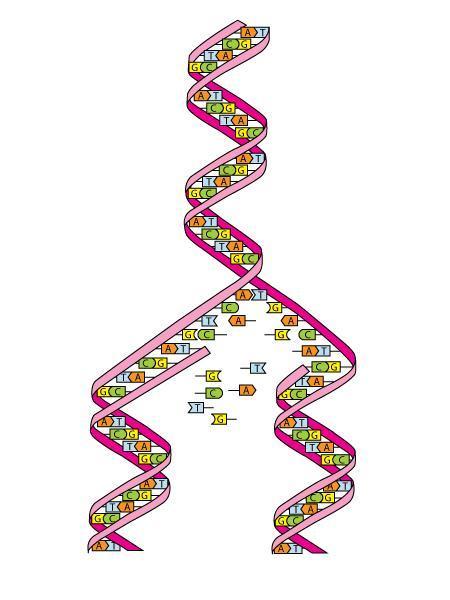
DNA unzipping & duplicating itself.
Each chromosome in the cell is duplicated – this process is called replication.
-
Passing on Chromosomes
Genes are passed down from one generation to the next on the chromosomes found inside the gametes.
Gametes are formed via the process of meiosis, which takes place in the ovaries (females) and testicles (males).

Meiosis of the giant water bug Lethocerus indicus.
Gametes have ½ the number of chromosomes that body cells have. And each gamete has a different collection of chromosomes.
Because each gamete has only 23 individual chromosomes (instead of 23 pairs), it will have only one gene for each trait, instead of two. At fertilization, the zygote will receive 2 genes for each trait (one from each parent).
-
Source: Science: NCEA Level 1 (New Zealand Pathfinder series).
2 notes
·
View notes
Text
Unit 3b: Reproduction
Gametes
Plants and animals produce special sex cells called gametes. There are two types of gametes:
eggs (larger & immobile)
sperm (smaller & mobile)
Eggs are produced by female organisms, so they're also called female gametes. Sperm is produced by male organisms, so they're also called male gametes.

A human egg surrounded by sperm (magnified 400 times).
Mating is the act of transferring sperm from male to female. A sperm must reach the egg for their genes to be combined.
For most plants, the flowers are the reproduction organs. Flowers usually contain both male and female organs (sperm are found inside pollen).
Pollination is the act of transferring pollen from the male to the female organs of the plant.
-
Gametes, Chromosomes and Fertilization
There is a complete set of genes inside each egg or sperm. Each gamete contains around 30,000 genes.
These genes are linked to one another in long strings called chromosomes.
A human gamete usually has 23 chromosomes, so a chromosome consists of thousands of genes.
After mating (or pollination), the sperm swim to the eggs. Fertilization occurs when one sperm fuses with an egg.

Early human zygote observed 18 – 20 hours after insemination. The two pronuclei (male & female) have not yet fused and combined their genetic information.
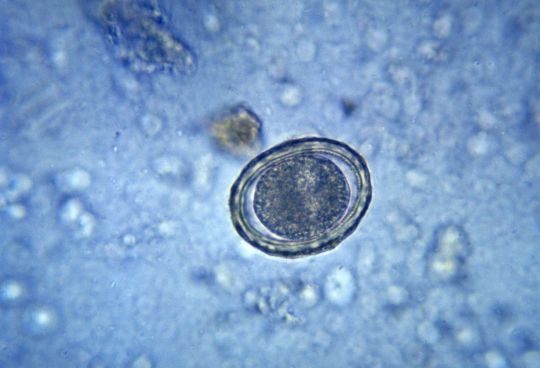
Fertilized egg of the roundworm Ascaris lumbricoides (multiplied 400 times).
The resulting cell is called a zygote. It's the start of a new organism.
The zygote has twice as many chromosomes as the sperm or egg. It has received 23 chromosomes from each gamete, so now it has 23 pairs (46 chromosomes in total). They're located in the zygote's cell nucleus.
A cell that has the full 23 pairs of chromosomes is diploid (most human cells are diploid). But gametes have only 23 individual chromosomes, so they are haploid.
-
Growth and Development
The zygote divides into two cells via the process of mitosis. Now there are two cells, each with a complete identical copy of the original zygote's chromosomes.
The new organism continues to grow, as the process of mitosis continues. Eventually it becomes an embryo, consisting of thousands of cells.
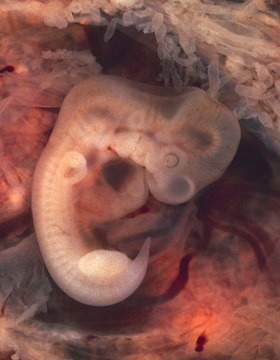
An embryo at the end of 7 weeks of development (derived from an ectopic pregnancy). It is 10mm in length.
Different cells become specialized into different tissues (e.g. skin, nerves & muscle). These form organs (e.g. arms & legs).
This process is called growth and development.
Growth & development continues until a complex organism is formed, made of millions of cells.
Each body cell has a set of chromosomes that are identical to those of the original zygote (due to the process of mitosis).
The zygote inherited a complete haploid set of genes from each parent Therefore, the growing organism has two genes for each trait (one from each parent).
The two genes for a particular trait may be identical (e.g. two genes for blue eyes). Or the two genes may code for different forms of that trait (e.g. one gene for blue eyes, and the other for brown eyes).
-
Mitosis
Mitosis is a process whereby a single cell divides once into two identical daughter cells (via cell division). The main purposes of mitosis are growth and replacing worn-out cells.
First, the DNA in the cell is copied in preparation for cell division. This results in two identical sets of chromosomes.
The membrane around the cell nucleus dissolves away, releasing the chromosomes.
A membrane forms around each set of chromosomes, creating two new nuclei.
The single cell pinches in the middle, forming two separate daughter cells. Each has a full set of chromosomes within a nucleus.
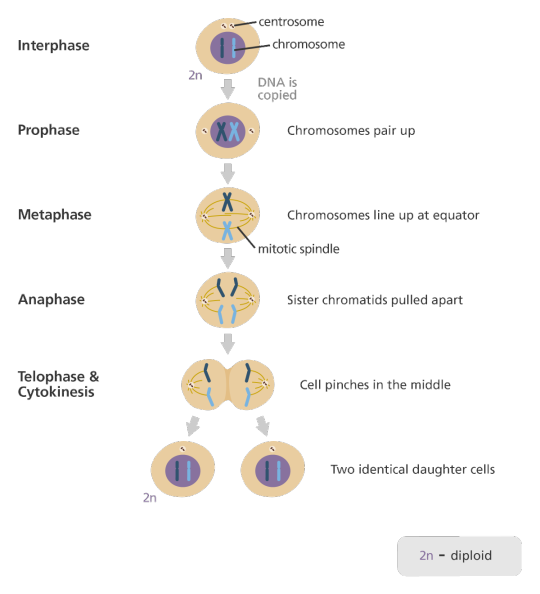
Diagram of mitosis.
-
Sex and Variation
A mature organism produces gametes from body cells via the process of meiosis. Female animals produce eggs in their ovaries, and male organisms produce sperm in their testicles.
The chromosomes are sorted so that each gamete gets half the number of chromosomes found in body cells, and so that each gamete ends up with a different set of chromosomes.
When a sperm & egg collide at fertilization, the new organism inherits a unique collection of chromosomes.
This process of allocating chromosomes at meiosis, and creating new combinations at fertilization, is what produces the variation seen among siblings.
It also helps to generate variation within plant & animal species. This is important for survival when the environment changes.
-
Meiosis
Gametes are formed via the process of meiosis. This is a process whereby a single cell divides twice to produce four cells, each with only 23 individual chromosomes (instead of 23 pairs of chromosomes).
First Part of Meoisis:
The DNA in the cell is duplicated, which results in two full sets of chromosomes. The pair of chromosomes may then exchange bits of DNA, in a process called recombination (or crossing over).
The membrane around the cell nucleus dissolves away, releasing the chromosomes.
The chromosomes are pulled apart, so that at each pole of the cell, a full set of chromosomes gathers together. A membrane forms around each set of chromosomes to create two new nuclei.
The single cell then pinches in the middle to form two separate daughter cells, each with a full set of chromosomes within a nucleus.
Second Part of Meiosis:
Now you have two daughter cells, each with 23 pairs of chromosomes. The second part of meiosis happens the same way to both daughter cells, at the same time.
A pair of chromosomes is made up of two chromatids, which are joined at the centromere.
As before, the membrane around the cell nucleus dissolves away to release the chromosomes. But now the pairs split apart, so that each chromatid of a pair moves to opposite ends of the cell. Now you have 23 individual chromosomes (or chromatids) at each pole of the cell.
A membrane forms around each set of 23 chromosomes to create two new cell nuclei. The cell pinches in half to form two new “grand-daughter” cells, each with only 23 individual chromosomes.
At the end of the process, there are four gametes, produced from one single parent cell.

Diagram of meiosis.
-
Twins
Identical twins are formed from a single egg and a single sperm. They combine to form a zygote, and the zygote divides into two cells as usual (each with the same set of chromosomes). But these two cells then separate, and each grows into an independent organism.
Each organism has identical genes, so they grow up to be identical twins.
Non-identical twins are formed from two eggs, each of which is fertilized by a single sperm. So non-identical twins are no more alike than regular siblings.
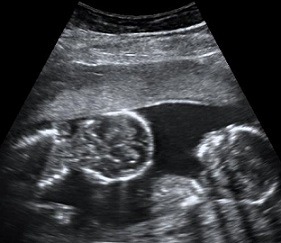
Abdominal ultrasonography of twins at gestational age of 15 weeks.
-
Source: Science: NCEA Level 1 (New Zealand Pathfinder series).
#science#biology#human biology#genetics#reproduction#prenatal development#botany#gametes#pollination#chromosomes#mitosis#meiosis
9 notes
·
View notes
Text
Unit 3a: Variation
Variation
Variation is the difference between individuals of the same species. In any randomly-selected group of humans, there are differences in features such as skin colour, eye colour, height, foot size, hair curliness and hair colour. These differences are divided into two groups: acquired variation and inherited variation.
An acquired characteristic is a non-heritable change in a function or structure of a living organism, caused after birth. Acquired characteristics can be caused by disease, accident or injury, deliberate modification, or other environmental influences. Two examples are sun tanning and hair curling.
An inherited characteristic is genetically determined – i.e. it is decided by what we receive from our parents at conception. Two examples are eye colour, and whether your earlobes are attached or free.
A trait is a specific characteristic of an organism (e.g. hair colour or blood type). Traits can be determined by genes or the environment, or (more commonly) by interactions between them.
-
Genes
The actual object that is inherited is called a gene. (Genes determine the appearance of inherited traits.) It is a unit of heredity, and is transferred from parent to offspring.
The genotype is the individual organism's unique set of all their genes. The genotype (along with environmental influences) determines the phenotype, which is the outward expression of the individual's genes – i.e. the observable physical properties of the individual (including their appearance, development and behaviour).
(“Genotype” can also refer to the two alleles inherited for a particular gene.)
A genome is all of the genetic material in an organism. It is made up of DNA (or RNA in some viruses), and includes genes and other elements that control the activity of these genes.
The human genome is mostly the same for all humans, though there are of course variations across the genome. This genetic variation accounts for about 0.001% of a person's DNA.

Visualization of sections of the human genome sequence at the Wellcome Sanger Institute (England).
-
Continuous Variation
A characteristic that changes gradually over a range of values shows continuous variation.
One example is human height. It ranges from the shortest to the tallest person, with any height between those values being possible. On a bar graph, this would likely show a bell curve.
-
Discontinuous Variation
A characteristic with a limited number of possible values shows discontinuous variation.
One example is human blood group. There are only 4 possible blood types (A, B, AB and O). There are no values in between.
Other examples of discontinuous variation include eye colour and sex.
-
Genetics
Genetics is a branch of biology concerned with the study of genes, genetic variation, and heredity in organisms. It studies how genes are expressed in plants, animals and human beings.
A basic assumption of genetics is that acquired variation cannot be passed on. Only inherited variation can be passed on through reproduction.
-
Siblings
Siblings often have similar features, but there are also many differences. Offspring can resemble one parent, or both parents.

Identical twins in utero.
Identical twins display a remarkable degree of similarity in their appearance, but non-identical twins are no more alike than regular siblings.
The principles of genetics can be used to explain how similarities and differences occur in a family.
-
Asexual and Sexual Reproduction
In some species (such as aphids & dandelions), a single parent can produce a single offspring. This process is called asexual reproduction. It produces offspring that are genetically identical to each other, and to the parent (because they have inherited the same set of genes).

Dandelion seeds.
Asexual reproduction can rapidly produce a large number of offspring, but there is no genetic variation.
Most plant & animal species reproduce via sexual reproduction. This involves two organisms, who combine their genes in some way to produce offspring.
This results in offspring that differ, i.e. it generates variation.
-
Source: Science: NCEA Level 1 (New Zealand Pathfinder series).
5 notes
·
View notes
Text
Unit 2b: Immune System
Catching and Fighting Off Disease
Pathogens cause many human diseases (though not all).
When a pathogen grows in your body, it causes an infection. The pathogen may damage tissue, or produce toxins (chemicals) that poison cells. Your body has some sophisticated defences against these pathogens.
Defence No.1 – Barrier & Chemical Warfare
Human skin is watertight, and acts as a barrier to keep out pathogens.
If pathogens do enter body openings, then the enzyme lysozyme (saliva, tears, nose mucus & urine) can kill microbes.
Stomach acid kills most of the bacteria in food.
Defence No.2 – Phagocytes (Generalists)
If the pathogens make it through to your body tissue, then phagocytes (patrolling white blood cells) attack and engulf them.
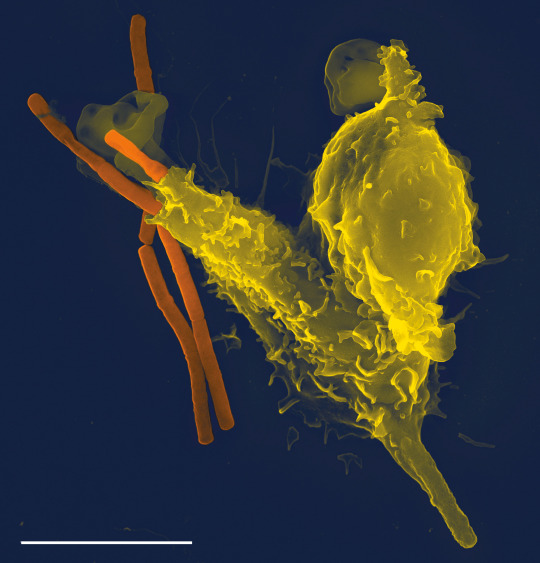
Scanning electron micrograph of a phagocyte (right) engulfing an anthrax bacterium (left).
Defence No.3 – Lymphocytes (Specialists)
Each type of pathogen has unique marker chemicals called antigens on their outer surface. These antigens escape into the blod.
White blood cells called lymphocytes absorb these antigens, and then release a chemical called an antibody (or immunoglobin) into the blood. Antibodies are large, Y-shaped blood proteins that your immune system uses to identify & neutralize foreign objects (such as pathogenic bacteria and viruses).
The antibody recognizes & destroys the pathogens that made the antigen. Different pathogens have different antigens, so your blood has many types of antibodies floating in it.

Scanning electron microscope image of a single human lymphocyte, with false colour modifications.
-
Disease-Spreading Agents
Air – e.g. cold & flu viruses from sneezing.
Water – e.g. girardia in lake water.
Food – e.g. listeria bacteria in shellfish.
Body fluids – e.g. HIV virus in blod.
Skin contact – e.g. thrush from touch.
-
Immunity to Disease
When you're first infected with a particular pathogen, the organisms multiply rapidly, which causes the symptoms of the disease. But as antibody levels slowly build up, the pathgens are killed.
Now you have natural immunity to further infection from that pathogen, because you already have large numbers of the right antibody in your blood.
A vaccine can give you artificial immunity to a disease, because you're injected with weakened or dead pathogens. These pathogens stimulate lymphocytes to produce the right antibody, which prepares you for a real infection.
Vaccination works for bacteria and viruses. But some viruses (e.g. colds & flu) mutate rapidly, so it's difficult to develop an effective vaccine.
-
Antibiotic Resistance
Antibiotics are chemicals produced by fungi that are very effective at destroying bacteria without damaging human cells. They can be taken internally as a medical drug (as pills or in solutions).
However, some bacteria develop resistance to a particular antibiotic.
Bacteria that belong to the same species aren't all the same, because their genes can change via mutation. So some bacteria acquire resistance to a particular antibiotic, and aren't killed by it. These resistant bacteria then multiply, and pass their resistant genes down to their offspring.
The bacteria that are vulnerable to the antibiotic are killed off, and the population gradually changes to a resistant strain. New antibiotics then have to be developed to fight these pathogens.
-
Source: Science: NCEA Level 1 (New Zealand Pathfinder series).
#science#biology#microbiology#human biology#medicine#immunology#virology#viruses#bacteria#fungi#blood#phagocytes#lymphocytes#antibiotics#vaccination#antibiotic resistance
1 note
·
View note
Text
Unit 2a: Helpful or Harmful?
Naturally Helpful
A decomposer is an organism (especially a soil bacterium, fungus or invertebrate) that breaks down dead or decaying organisms (e.g. in compost heaps). This process is called decomposition.
Many bacteria & fungi are decomposers. They release chemicals (nutrients) that plants can then absorb, and form an important part of the carbon & nitrogen nutrient cycles.
Decomposers release carbon from the dead matter into the atmosphere, in the form of CO2 gas. Plants then absorb the carbon dioxide gas as they manufacture food.
Decomposers return nitrogen to the atmosphere via their actions. They break down the complex nitrogen compounds in dead organisms & animal wastes, which returns simple nitrogen compounds to the soil. Plants can then use these compounds to make more nitrates. Overall, crop productivity is increased.
Nitrogen fixation is any natural or industrial process that causes free nitrogen (N2 gas in the air) to chemically combine with other compounds, and thus form compounds that are more reactive (e.g. ammonia, nitrates and nitrites).
Plants like clover have nitrogen-fixing bacteria in their roots. These bacteria carry out the above process, converting N2 gas from the air into nitrates. This also increases crop productivity.
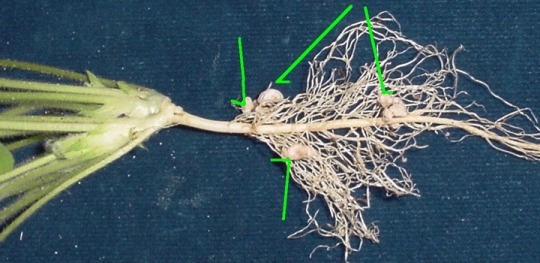
Specialized bacteria that live in lumpy nodules on clover roots help the plant fix nitrogen from the air.
Cellulose is the main constituent of plant cell walls, and vegetables fibres such as cotton. It is an insoluble solution, and humans are incapable of digesting it.
Herbivores such as cows & pigs have cellulose-digesting bacteria in their gut. These bacteria help to break down the thick cell walls of plant tissue, thus giving the animal extra nutrition.
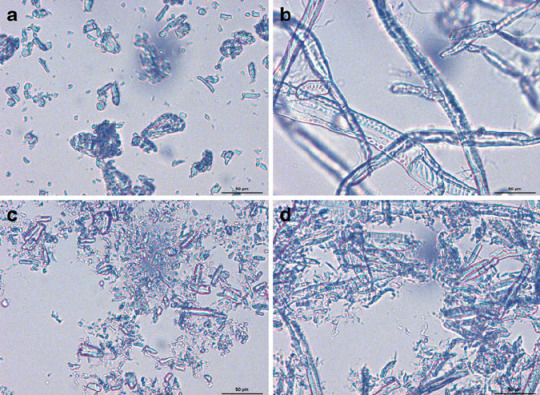
Optical microscope images of celluloses.
-
Biotechnology
Humans have found many ways of using micro-organisms to produce foodstuffs, better crops, medical drugs and consumer products. This use of microbes for human ends is called biotechnology.
In its broadest sense, biotechnology is the commercial exploitation of living organisms or their components (e.g. proteins). Basically, it is technology that utilizes biological systems.
Yoghurt bacteria convert lactose sugar in milk to lactic acid. The lactic acid solidifies the milk into yoghurt.
The bacteria used to make yoghurt are Lactobacillus delbrueckii subsp. bulgaricus and Streptococcus salivarius supsp. thermophilus. They are classicied as lactic acid bacteria.
Other bacteria are involved in curdling milk for cheese-making.
Pharmaceutical companies use genetically-engineered bacteria to produce chemicals for medical drugs. Special bacteria are used to produce insulin, which diabetics use to control their blood sugar levels.
Yeasts are an important group of fungi. They convert sugar into CO2 and alcohol via fermentation (a form of anaerobic respiration). Yeasts are used to make bread rise, and ferment beer & wine.

Yeast making bread rise via fermentation.
Some fungi are used to produce chemicals called antibiotics.
An antibiotic is a type of antimicrobial substance that inhibits the growth of bacteria, or destroys bacteria. Antibiotics are the most important type of antibacterial agents for fighting bacterial infections.
Some viruses are used to control pest organisms. Calicivirus (RCD) was illegally released in NZ by farmers to control rabbit populations. This use of microbes is called biological control.
Biological control (also called biocontrol) is a method of using other organisms to control pests. It relies upon natural mechanisms (e.g. predation or parasitism), and typically involves an active human management role.
-
Harmful Micro-Organisms
A pathogen is a microbe that causes disease. Pathogens are also called infectious agents, because they cause infections.
Other microbes cause harm by damaging foodstuffs, crops and fabrics. They aren't classified as pathogens because while they do cause harm, they don't cause disease.
All viruses are pathogens. They cause many human diseases, from colds and flus to serious diseases such as polio, hepatitis B and AIDS.
Some bacterial species cause food to rot. You can see colonies of bacteria as shiny spots on meat that has gone off.
Listeria bacteria (sometimes found in shellfish) can cause food poisoning or damage foetuses.
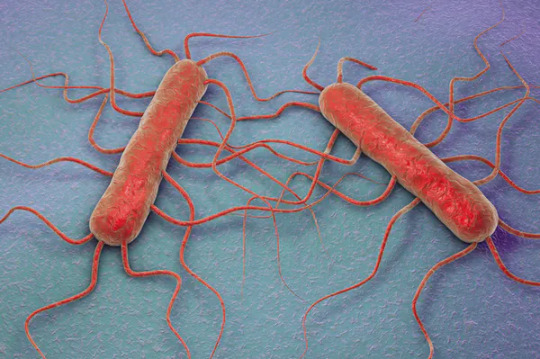
A 3D illustration of Listeria monocytogenes, the species of pathogenic bacteria that causes the infection called listeriosis.
Different fungal species can cause make food rot (e.g. bread mould & potato blight), make fabrics go mouldy, or cause wet rot in timber.
Some species of fungus infect humans (e.g. thrush & athlete's foot).
-
Antiseptics and Disinfectants
An antiseptic is an antimicrobial substance that kills or inhibits the growth of micro-organisms on intact skin. An antiseptic is applied to living tissue or skin, and will reduce the possibility of infection, sepsis or putrefaction.
A disinfectant is a chemical substance that is used to destroy (or inactivate) micro-organisms on inert surfaces. Disinfectants are generally strong chemicals used around the home.
-
Source: Science: NCEA Level 1 (New Zealand Pathfinder series).
#science#biology#microbiology#chemistry#biochemistry#botany#biotechnology#biological control#virology#bacteria#viruses#fungi#carbon cycle#nitrogen cycle#fermentation#yoghurt#alcohol#carbon#nitrogen
8 notes
·
View notes
Text
Bacteria, Fungi & Viruses
Micro-Organisms
Micro-organisms (also called microbes) are very small organisms that can usually only be seen with a microscope. Sometimes it's possible to see a colony of microbes with the naked eye.
A microbe that is only one cell is unicellular; a microbe made of two or more cells is multicellular.
While micro-organisms aren't easily seen, it's still possible to see the results of their activity. Harmful micro-organisms can spoil food, damage crops and cause diseases.
An organism is a living object – an organic, living system that functions as an individual entity. (Most biologists agree that viruses do not count as organisms.) All organisms are made of cells, and need the essential life processes to survive.
The essential life processes are:
movement
respiration
sensitivity
circulation
growth
reproduction
excretion
nutrition
The acronym for remembering this list is MRS C. GREN.
The three types of micro-organisms are bacteria, viruses and fungi.
-
Bacteria (Structure)
There are thousands of different types of bacteria (some unicellular, some multicellular).
The bulk of the bacterial cell is the cytoplasm, where the chemical reactions of life occur. This is a thick solution that fills the cell, and is composed mainly of water, salts and proteins.
The cell membrane encloses the cytoplasm, and controls the entry and exit of chemicals.
A stiff cell wall encloses the cell membrane, and provides support to it.
Some bacteria can swim, using a propeller-like flagellum (pl. flagella).
Bacteria have no cell nucleus. The genes of a bacterium are located on a chromosome that floats in the cytoplasm. This chromosome controls the activities of the bacterium.

Basic diagram of a bacterium.

Transmission electron micrograph of Desulfovibrio vulgaris, showing a flagellum at one end of the cell.
-
Bacteria (Roles)
Most bacteria are consumers (i.e. they can't make their own food).
Parasites live in/on larger organisms, and feed off them.
Saprophytes consume dead matter (e.g. compost). This can be dead organisms, or products of organisms.
Pathogens cause disease by damaging tissue, or producing toxins.
-
Bacteria (Life Processes)
Bacteria feed by secreting enzymes onto dead or living matter. This breaks down the larger molecules into smaller molecules, so that they can be absorbed by the bacteria.
This is called extra-cellular digestion (i.e. it happens outside the cell) as opposed to intra-cellular digestion (which happens inside the cell).
Bacteria use a process called anaerobic respiration to release energy from these food molecules. (Anaerobic respiration requires oxygen.)
However, some bacteria can release energy from food without the presence of oxygen. This is called aerobic respiration.
Bacteria excrete by allowing wastes to diffuse out through the cell membrane, into the environment.
As bacteria feed, they grow larger. They engage in reproduction using the process of binary fission. This is how it works:
The chromosome is duplicated.
The cell pinches in half.
Two separate “daughter cells” are formed (each with their own chromosome).

Diagram of a bacterium undergoing binary fission.
This is asexual reproduction, because it occurs without sex. It is faster than sexual reproduction, but the drawback is that the offspring have identical genes to the “parent” bacterium.
In inhospitable conditions, some bacteria form resistant spores that can survive for years. When the spores land on dead or living tissue, they germinate and multiply.
-
Viruses
Viruses are extremely small objects, much smaller than bacteria. They cannot feed or move, and the only life process they carry out is reproduction (and they must do this by taking over living cells).
Viruses are not cells, and they are not alive – therefore they are not considered to be micro-organisms.
There are thousands of different types of viruses.
A virus is made up of a string of genes coiled up inside a protein coat. The protein coat can form different shapes.

Basic diagram of a virus.
Viruses are very efficient at reproduction. They use a process called replication:
A virus lands on the surface of a cell.
It inserts its genes into the host cell.
The viral genes take over the cell.
They make the cell assemble thousands of copies of the virus.
The host cell eventually ruptures.
This releases the new viruses, which then spread to other cells or organisms.
The genes of a virus readily mutate (change). This is why new strains of viruses emerge regularly (e.g. the new strains of cold and flu viruses every year).
A virus is a pathogen, because it always damages the host cell.
Viral diseases include colds, influenza, hepatitis B and AIDS.
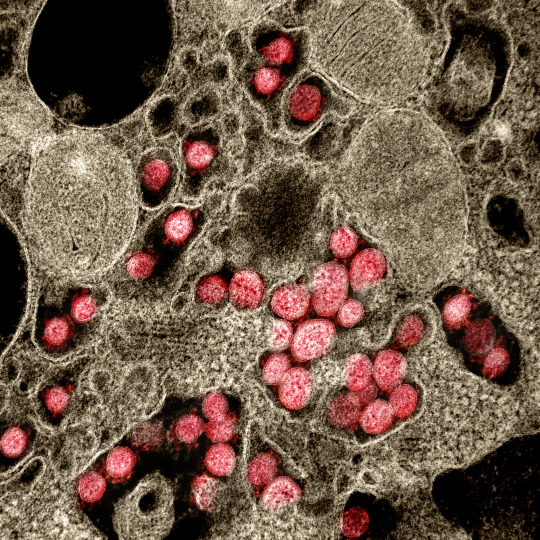
Transmission electron micrograph of SARS-CoV-2 (COVID-19) virus particles (in red) isolated from a patient.
-
Fungi (Life Processes)
Fungi are a large group of organisms, including unicellular yeasts, and multicellular moulds, mushrooms and toadstools.
Like plants, fungi are immobile; but unlike plants, they are consumers and cannot make their own food. They have to live off other organisms.
Most fungal organisms are saprophytes (consuming dead matter). Some are parasites on living organisms, absorbing food from them. Fungi that are human parasites can cause thrush or athlete's foot.
Multicellular fungi are made up of hyphae. These are very fine feeding threads that invade the tissue of the host organism or food.

Hyphae of a mushroom.
Like bacteria, fungi release digestive enzymes onto their food, and then absorb the digested food (i.e. via extra-cellular digestion). Fungi can carry out aerobic and anaerobic respiration to obtain energy from food. They excrete wastes in the same way that bacteria do.
Fungi are spread by spores – microscopic cells with tough walls. They are produced by sporangia (special spore capsules).
Millions of spores are released to float in the air (spore dispersal). They eventually settle on dead or living tissue, where they germinate, sending out hyphae. The hyphae grow rapidly, and invade the new host.
(If there is no suitable tissue, they remain dormant.)
When a single parent produces the spores, this is a form of asexual reproduction, producing genetically-identical offspring. Fungi can also reproduce sexually, which results in variation amongst the offspring.
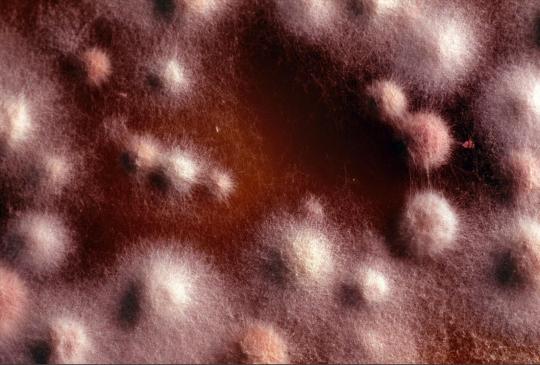
A microscopic view of cultured athlete’s foot fungus.
-
Culturing Micro-Organisms
Micro-organisms can be grown on a special medium called agar, a jelly-like substance that contains all the nutrients needed for the growth of microbes.
The sterile agar is heated, and then poured into a petri dish, where it sets into a jelly.
To grow bacteria or fungi in a petri dish:
Lightly wipe a cotton bud over the surface of the object that you're investigating.
Lift the petri dish lid, and gently brush the bud over the surface of the agar. This technique is called inoculation – the introduction of cells onto agar to culture (grow) them.
Quickly replace the lid. Place the dish upside down (to prevent water from condensing on the agar) and seal it with tape.
Place the petri dish in a warm place for several days. This is called incubation – growing microbes on agar in warm conditions.
Factors that affect growth rate include warmth, oxygen, moisture, acidity and nutrients.

Petri dish with micro-organisms isolated from a deepwater sponge.
Source: Science: NCEA Level 1 (New Zealand Pathfinder series).
27 notes
·
View notes
Text
English History (Part 8): The Anglo-Saxons
In 430, Vortigern hired Saxon mercenaries to defend England against the Picts (from Scotland) and marauding bands from Ireland. Vortigern was the leader of the confederacy of small kingdoms that England was divided into, and this was a common strategy (the Romanized English had used it at various times).
The Irish landed on the west coast of England, within easy reach of the Cotswolds. The central part of Vortigern's kingdom was situated in that region, so that may have been the reason he was the leader in this struggle. The Picts, it was reported, had landed in Norfolk. The sailors painted their ships and bodies the colour of the waves, so they couldn't be seen so easily.
According to historical legends, the Saxons arrived in three ships, each holding 100 men at most (there were probably more ships than that). The Saxon mercenaries were well-known for their ferocity and valour. They worshipped Woden (god of war) and Thor (god of thunder), practised human sacrifice, and drank from their enemies' skulls. They shaved the front of their heads, and grew their hair long in the back, so their faces would seem larger in battle. A Roman chronicler of the 400s stated, “The Saxon surpasses all other in brutality. He attacks unforeseen, and when foreseen he slips away. If he pursues, he captures; if he flees, he escapes.”
The main part of the Saxon force was stationed in Kent, and they were given the Isle of Thanet in the Thames Estuary. Other groups of soldiers were stationed in Norfolk, and on the Lincolnshire coast; they also guarded the Icknield Way. The remains of the Romanized armies (in the north) were stationed in York, which was strongly fortified.
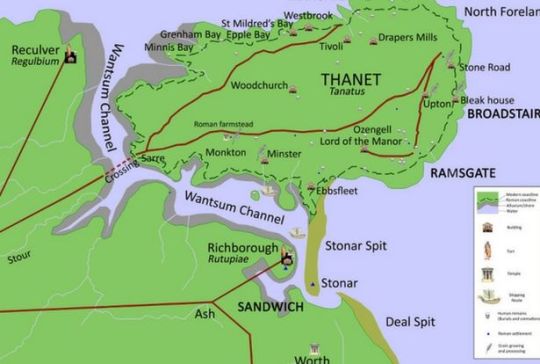
The Wantsum Channel no longer exists, so the Isle of Thanet is now part of the mainland.
This show of strength seems to have been enough. The Picts gave up their plans for invasion. The Irish were held back by the tribal armies of the west and west midlands; the kingdom of the Cornovii (with their capital at Wroxeter) played an essential part in this.
But Vortigern's allies either would not or could not pay the Saxon mercenaries, and also refused to give them land instead of coin. According to the Kentish chronicles, the English declared that “we cannot feed you and clothe you, because your numbers have grown. Leave us. We no longer need your assistance.”
The Saxons immediately rose up, with the uprising beginning in East Anglia and spreading down to the Thames Valley. They took over many of the towns & countryside regions in which they had been stationed; they appropriated large estates and enslaved many of the native English. Then, the Saxon federates encouraged their compatriots to come and join them. The land was prosperous, and Thanet itself, as a granary, was especially prized.
Four main tribes provided most of the migrants – the Angles (Schleswig), Saxons (regions around the River Elbe), Frisians (north coast of the Netherlands) and Jutes (coast of Denmark). The river system provided already-established routes of settlement, so the settlers advanced along the Thames, Trent and Humber.
The Angles settled in east and north-east England, and by the early 500s, the people of east Yorkshire were wearing Anglian clothes. The Saxons settled in the Upper Thames valley; the Frisians were scattered over the south-east, with an important influence in London. The Jutes settled in Kent, Hampshire and the Isle of Wight (the New Forest was once Jutian land).

In some places, the Anglo-Saxons (who weren't called that yet) were welcomed; in other places they were resisted. In some places, they were accepted by the working population who had no real love for their native masters. Eventually, the Anglo-Saxons made up about 5% of the population we now call English, and it may have been about 10% in the eastern regions. However, there is no evidence for the deliberate genocide and replacement of the native population.
One of the reasons for their migration to England was that they were being pushed westwards by other tribes in the great westward migrations of that time period. Another reason was the rising sea, which was causing the northern European coastline to sink.
The Saxon revolt led to the downfall of Vortigern, who was overthrown by Ambrosius Aurelianus, another Romanized English leader. Aurelianus led a counterattack against the Saxons, and engaged in a series of battles that lasted for 10yrs. In 490, the English won a great victory at Mons Badonicus, which was probably near modern-day Bath.
The leader of the English forces for that battle is unknown. However, the name of Arthur is mentioned as dux bellorum (leader of warfare), and he is said to have taken part in 12 battles against the Saxons. He may have been a military commander with his headquarters within the hill fort of Cadbury. During his supposed lifetime, 7.2 hectares of that hill fort were enclosed.
However, as part of the spoils of war, the Saxons kept control over Norfolk, East Kent and East Sussex. There was a division in the country – Germanic tribes with their warrior leaders to the north, and small English kingdoms to the south. The division may have been marked by the construction of the Wansdyke, designed to keep the Saxons from crossing over into central southern England.
Some of the most Romanized parts of England were now controlled by “barbarians”, and so the town and villa life receded greatly. Gildas (an English chronicler of the early 500s) complained that “the cities of our contry are still not inhabited as they were; even today they are squalid deserted ruins.”
However, some of these towns and cities were still actively used as markets and places of authority. The Saxons set up their own trading area outside the walls of London (the modern-day district of Aldwych), but the old city of London was still a place of royal residences and public ceremonial activities.
In the countryside, things carried on much as usual, and there wouldn't have been any changes in agricultural practice. The Germanic settlers laid out the same field systems, and respected the old boundaries – for example, Germanic structures in Durham were set within a pattern of small fields & drystone walls from prehistoric times.
Furthermore, the Germanic settlers respected the lie of the land, and formed groups that followed the boundaries of the old tribal kingdoms. At a slightly later date, the sacred Saxon sites followed the alignment of Neolithic monuments.
For the next 2-3 generations, the English kept the Germanic settlers within their boundaries. At this time, the average life expectancy was 35 years.
But by the middle of the 500s, the Germanic peoples wanted to advance further west, to exploit the productive lands there. The main reason for this sudden expansion probably was the bubonic (and perhaps pneumonic) plague that spread from Egypt to all over the previously-Romanized world, during the 540s. The native English were struck down by it (and the Germanic peoples weren't), and the population may have dropped from 3-4 million to 1 million. There were fewer people living on the land, and fewer men to defend it. The Angles and the Saxons took advantage and moved westwards.
Ceawlin of Wessex, one of the Saxon leaders, reached as far as Cirencester, Gloucester and Bath by 577. Seven years later, his forces had penetrated the midlands, and the native kings were deposed. This was the pattern throughout England.
Pressure was growing on the Durotriges (Somerset & Dorset), and many native people left for Armorica, on the Atlantic coast of north-western France, where their leaders took control of large areas of land. They may have been welcomed there, as they may have been part of the same tribe. The region of Brittany emerged there, and the Bretons retained their old tribal allegiances, never really thinking of themselves as part of the French state. Some returned to England – the forces of William the Conqueror included a Breton contingent, and they chose to settle in south-western England.
Eventually, the native English would be mixed with the settlers, and terms like Saxon or Angle would no longer have any meaning – everyone would be English. But it was a slow process. 200yrs after the first Saxons arrived, much of western England was still under the rule of native kings. The kingdom of Elmet (now the West Riding of Yorkshire) survived until the early 600s. The “Anglo-Saxon invasion” really only came to an end in 1282 when Edward I captured Gwynedd (leader of a kingdom in north-western Wales). There were still Celtic speakers in Cornwall at the beginning of the 1500s, and the language didn't die fully until the 1700s.
#book: the history of england#history#military history#colonialism#anglo-saxon settlement of england#battle of badon#britain#anglo-saxon britain#england#wales#saxons#angles#frisians#jutes#wessex#durotriges#elmet#vortigern#ambrosius aurelianus#king arthur#ceawlin of wessex
5 notes
·
View notes
Text
British History (Part 7): Climate
In south-east England the summers are warm and the winters are cold; in north-west England the summers are cool and the winters are mild. The western coast of England has 40% more rainfall than the eastern coast. The main autumn & winter wind is from the south-west; the main spring wind is from the east.
In the north and west of England are the moors and mountains, and the soil is thin. This ground was better for livestock rather than crop farming, so the farmers grew only as much corn as they needed for themselves.
In the south and east of England are the lowlands, with gradual undulations in the rich earth. This ground was good for both cattle and corn, or “mixed farming”.
Climate patterns have always been very important in English history. A temperature drop of two degrees (such as from 500 – 300 BC), harvests in the north are far more likely to fail. A temperature drop of only one degree makes it seven times more likely the harvest will fail. When this happens, there is evidence of abandoned upland farms and settlements.
On the other hand, the south of England is warmer, and more stable. The general dampness meant that crops could also be grown on lighter soils (where sand and chalk were dominant).
Generally, wheat was grown in the south-east, and oats in the north. However, there were important regional variations. Suffolk grew wheat, and Norfolk grew rye (both these countries are in the east of England). Lancashire (in the north-west) grew mostly oats, but Yorkshire grew mostly rye. In Wiltshire (in the south-west), wheat and barley dominated. West of Wiltshire (Somerset?) barley was dominant.
The southern English were wealthier than the northern English. The east of England is drier than the west, which may have been part of the reason for the differences in social systems during the 1st millennium BC – there were more scattered settlements in the east, and small centres of lordly power in the west. The village and manorial system of common cultivation were the norm in the south & east; the isolated farmhouse and small hamlet in the north & west.
During the Roman era, the weather was warmer and wetter than it would be at any time between then and now. But at the end of the 300s AD, colder and wetter conditions prevailed. For a decade from 536, there was a very low level of sunlight, which would have led to famine. King Alfred is credited with inventing a clock that allowed him to tell the time when fog obscured the sun.
The 1000s and 1100s had an increase in temperature, but in the 1200s and 1300s the climate got worse. Annals of those centuries mention increasing occurrences of floods and droughts. Hard frosts lasted into spring, and violent gales brought down trees in the forests. The Thames froze in the winter of 1309 – 10, and 1315 & 1316 had endless rain. Harvests failed, the dead were buried in common graves, disease was epidemic, and crime rose.
Because of the increased rainfall of the 1300s, drainage ditches and house platforms were built, church floors were raised, and the lower halves of some villages were deserted. The carpenter in Chaucer's The Miller's Tale speaks of the fear of another Great Flood. There was a great wind on January 14th, 1362, which was widely believed to be a harbinger of the Day of Judgment.
#book: the history of england#history#prehistory#geography#climate#agriculture#christianity#iron age#britain#iron age britain#roman britain#england
17 notes
·
View notes
Text
Siberian History (Part 8): To the Pacific Ocean
The Russians had first heard about the Lena River (the easternmost of the three great Siberian rivers) from the Evenks (called Tungus at the time). The Evenks also told the Russians about the Yakuts, or “horse people”, who lived along its shores.
The Yakuts were pastoral nomads who had originally lived in regions further south. But upheavals accompanying the rise of Genghis Khan forced them to flee northwards, and they eventually settled along the middle Lena River. There, they continued to breed cattle and horses despite the harsh climate, sheltering them in their own houses during the winter.
Russians set out on expeditions from Yeniseysk and Mangazeya, reaching the Lena's western tributaries from the Yenisei's eastwards branches. They travelled across short portages of low rolling hills, and entered the river basin from the north and south.

But rival exploring parties from Tomsk and Tobolsk soon showed up as well. Eventually, the government sent the Cossack Petr Beketov, who had already subjugated the Buryats and Evenks along the Angara River, and the conquest of the Lena really began.
In 1631, he portaged from Ilimsk (founded 1630) to the Lena with 30 men. They then travelled up the Lena, built a fortified camp of fallen trees, and forced the local Yakuts to pay them tribute.
In 1632, Beketov founded Yakutsk on a large bend of the Lena River, and Zhigansk to the north. (Yakutsk would later be used as a base for expeditions to the Arctic and Pacific Oceans.)
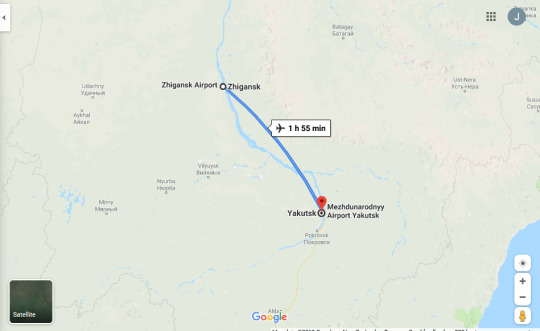
He founded Amginsk (Amga-Sloboda?), Vilyuysk (1634), and other outposts on tributary streams. Olyokminsk was founded at the junction of the Olyokma and Lena Rivers in 1635.

I think Amga is the (approximate?) location of Amginsk.
Cossack bands from various towns had begun to fight among themselves for a share of the spoils. Some even became involved in intertribal wars, on opposing sides, with some kind of hometown pride or loyalty.
In some places, tribute was collected 2-3 times from the locals, which led to uprisings (the people here had been easily subdued at first). These uprisings led to a decline in revenue for the Treasury, so in 1638 Moscow designated Yakutsk as the headquarters of a separate administrative district, from which servicement from all other districts were banned. However, this was only partially successful.
The conquest of Western Siberia had been methodically planned, but this was not the case for the east. This was a more rugged country, with frontier fortresses creating tiny islands of domination in this giant land. The Lena was about 4000km from the Ural Mountains – they were so remote from Kremlin directives that local authorities, and even individual groups, took the initiative.
Most Cossack or exploring parties were no more than 20-30 men, and some had fewer than 10; the men were called promyshlenniks (hunters and trappers). They led the way, with the state following after them, instead of the other way around as it had been in the east. They built forts to command rivers and portages, and to supervise the collecting of tribute.
At times, the lack of an organized military seemed to give the native peoples a fighting chance. In particular, the Buryats continued to fiercely resist the Russians' incursions, and their guerrilla tactics were very effective in the mountainous terrain. But in 1648, the Russians managed to ascend the Angara River as far as Lake Baikal. The Cossack Kurbat Ivanov (the first Russian to discover the lake) then crossed it, and after fierce fighting he imposed yasak (fur tribute) on the Buryats who lived on its eastern shores.
In 1649, Ivan Pokhabov (a commander from Yeniseysk), renovated the fort of Bratsk on the Angara River (which had been founded in 1631), and strengthened it with moats and parapets. He also led another party across Lake Baikal to the mouth of the Selenga River, finding himself on the Mongolian frontier.
He found that the local Buryats traded furs for silk, silver, and other goods from Outer Mongolia. He sought the warlord or khan of the eastern Mongols, Altan Khan of the Khalkha, but the khan claimed to have no silks or silver of his own, except for what he obtained from the Chinese.
Meanwhile, progress was being made with fort-building. Forts were built at Verkholensk (1641), Verkhneangarsk (1646), Verkhneudinsk (1648) and Barguzin (1648). These forts were on the sides of Lake Baikal.
In 1652, a fort was built at Irkutsk, at the junction of the Angara and Irkut Rivers.

Verkhneangarsk is now Nizhneangarsk. Verkhneudinsk is now Ulan-Ude.
The native peoples were forcibly baptized. “Those who did not willingly consent were driven into the Stream, and when they came back, a Cross was hung around their necks.” Another method was to tie 2-3 Buryats to a long pole, and plunge them through a hole in the ice into the freezing water. The Buryats attacked the Bratsk garrison in response to this treatment.
Petr Beketov was sent to restore the tsar's authority in 1652. During the year of 1653, he explored the Selenga, Ingoda and Shilka Rivers on rafts, and founded Irgensk. In the spring, he established Nerchinsk, across from the mouth of the Nercha River.

While the Yenisei River was being brought under control, progress was also being made on the Lena River. The conquest from Yakutsk proceeded in three direction – north-east to the Bering Strait, the Bering Sea and Kamchatka; eastwards to the Sea of Okhotsk; and southwards to the Amur River Valley.
Two years after reaching the Lena River, the Russians had followed the Aldan River up to its source in the Stanovoy Mountains. In 1639, 20 men under the command of Ivan Moskvitin set off to find what the native peoples called “the great sea-ocean”. They travelled up the Maya and Yudoma Rivers, throught a mountain pass, and down the Ulya River to the Sea of Okhotsk, part of the northern Pacific Ocean. They had now crossed the whole of northern Asia.
#book: east of the sun#history#military history#colonialism#geography#economics#trade#russian conquest of siberia#native siberians#evenks#yakuts#buryats#russia#mongolia#siberia#khotogoids#yakutsk#zhigansk#amginsk#vilyuysk#olyokminsk#bratsk#verkholensk#verkhneangarsk#verkhneundinsk#barguzin#irkutsk#nerchinsk#cossacks#petr beketov
31 notes
·
View notes
Text
English History (Part 6): Roman Britain
While the Romans didn't like the sea, they were greatly attracted to England for its wealth and surplus of corn. Caesar's invasion of 55 BC was more of a scouting mission; he said that he wanted to acquaint himself with “the lie of the land”. Britain was already a trading partner of Rome, and was rumoured to be rich in metal and wheat. Some of the British tribes were already allied with the northern Gauls, whom Caesar was fighting.
Several of the tribal leaders sent emissaries to him, as they were informed in advance of his preparations. Caesar sent an envoy in return, who urged the tribal leaders to collaborate with him.
The Romans set sail with two legions (each with about 5000 men) in 80 ships. They landed near Deal (Kent), where the English were watching them. There was a skirmish on the beach, which the Romans won, and the tribal leaders sued for peace.

But a storm arose, made worse by a high tide at the full moon. The Romans weren't aware of this phenomenon, and all their ships were damaged.
The English took the opportunity to attack, breaking the peace agreement. A number of skirmishes took place in the immediate vicinity of Deal. Caesar was hard-pressed, and knew that he had to retreat back across the water. He managed to get the ships repaired, and sought material aid from Gaul. He left, with many hostages from the English, vowing to return.
He returned the next year, this time with 800 ships, 25,000 infantry and 2,000 cavalry. This was a proper invasion, and the English tribes, instead of warring among each other, were now united in the face of this threat. They chose Cassivellaunus, who was king of territory north of the Thames, as their war leader.
The English fought the Romans as they usually fought each other. There were warriors in chariots, on horseback and on foot, with each attacking & withdrawing at appropriate moments. Cassivellaunus had an army of 4000 chariots, and they had a specific strategy – the chariot-driver would drive to the front line, let the warrior jump out, and then retire and wait for him to return. According to Caesar, by steady practice the English “attain such proficiency that even on a steep incline they are able to control the horses at full gallop, and to check and turn them in a moment.”
But the discipline of the Roman army was enough to withstand all this. There were a number of battles, and then the English were forced to retreat into the woods. Caesar followed them, and destroyed Cassivellaunus' stronghold. The chieftains sought peace, and Cassivellaunus capitulated in the end. Caesar took hostages and tribute, and returned to Rome.
There wasn't another invasion for 90yrs, but the Romans had left their mark. Southern Britain was gradually Romanized, with tribal leaders beginning to import wine and luxury goods from Rome. The elites' dwellings began to change shape from round to rectilinear – strong evidence of cultural transition. The southern tribal leaders would have wanted to imitate the victors.
Some of them changed their allegiance and became the client kings of Rome. Strabo states that they sent embassies and paid court to Augustus (first Emperor of the Roman Empire), in order to gain his friendship. They exported grain, iron and slaves; and they imported glass vessels, amberware and other goods. Of course, they had to pay duty to the Roman state on these goods – an excellent way of binding them to Rome.
In the early 40s AD, the Atrebates (a Belgic tribe) were conquered, and their king Verica fled to Rome, appealing for help. Emperor Claudius was new to his position, and was yet to prove himself in the field. He now had the excuse he needed for the proper invasion of Britain, which came in 43 AD.
Four legions of about 20,000 men, under the leadership of Aulus Plautius, landed at two separate locations so as to confuse any English counterattack. The tribes dispersed, but rallied for a major battle by the River Medway, in south-east England. There the fighting lasted for two days, with the English (under the leadership of Caratacus) were being defeated. The exact location of the battle is not known.
Plautius sent for Claudius, who arrived two months later with 28 elephants. He stormed the native capital of Camulodunum, and Caratacus fled westwards. Eleven kings surrendered to Claudius, and he was celebrated for it when he returned to Rome. The Roman conquest of Britain had begun, but it would take nearly 40yrs for it to finish.
Camulodunum became the first Roman capital of Colchester. They built a great fort on the site of the native earthworks, as a token of dominion. The army then spread outwards in three directions – north, west and north-west.

Vespasian, leader of the western army, drove towards Wales and England's south-west peninsula, fighting 33 battles along the way. On the banks of Maiden Castle (a hill fort in Dorset), the body of a man with a Roman crossbow bolt in his spine has been found. By 49 AD, Roman soldiers were supervising mining operations in Somerset.
The other two armies proceeded slowly along already-existing roads such as Ermine Street. They built forts in areas they conquered, so that each tribal zone was dominated by at least one military settlement. By 51 AD, Cartimandua (queen of the Brigantes in the north) had become a client queen. She was receiving Roman wine in Roman vessels, and also building tiles.
Although Roman historians describe a smooth process of colonization, it is unlikely that it was as simple as that. They did advance steadily, but they were beset by tribal rebellions, and occasionally army mutinies. Ambushes, raids and battles were common. South of the Fosse Way (running from Exeter to Lincoln), all the land was under Roman control, but in the north it was more treacherous. Some tribes had divided allegiances, and some fought against each other.

The Fosse Way.
The Iceni, a tribe living deep within East Anglia (a pacified zone) revolted in 47 AD over the right to bear arms. It was put down easily.
King Prasutagus of the Iceni died in 60 AD, and the agents of the Roman provincial government tried to appropriate Iceni wealth. Boudicca, Prasutagus' widow, was flogged and her two daughters were raped. Boudicca rose up and led a rebellion against the Romans.
She gathered other English tribes into a confederacy and led her army southwards, burning and pillaging any evidence of Romanization, or the beginnings of it. They destroyed villas and killed inhabitants by the sword. The object of their advance was the capital of Colchester, which harboured hundreds of military veterans who had taken control of adjacent land. The English set the city on fire and destroyed it, and looted the shops.
The veterans sheltered in the central temple, but two days later they were overwhelmed and hacked to pieces. The English beheaded a great statue of Claudius and threw it into the river, and destroyed the temple itself.
They then moved further southwards, towards London. On the way, they sacked Chelmsford and St. Albans, and killed an entire legion.
Suetonius Paulinus was the Roman military governor at that time, and he had been campaigning in Wales. Well aware of the threat to his regime, he marched quickly back, but he didn't save London when he arrived there. He needed to focus on saving the whole imperial province, and to do that he had to pick the time & place for the battle.
Many London inhabitants hastily left the city, going further south to safety with pro-Roman tribes. Those who remained were killed – Tacitus states that 70,000 peoplle were killed in the attack. London was razed by fire, leaving a red level of oxidized iron that is still beneath the streets of modern London. 48 human skulls have been found embedded in the track of the Walbrook river.
Boudicca now went after Suetonius Paulinus, but the site of the battle is not known for certain. There were 10,000 Roman troops, and 100,000 English. The Roman legionnaires had a forest behind them, and a plain in front of them. The English ran across the plain towards them, but many were killed by javelins. Then the Romans began to move forward with shields and shortswords. It was their discipline that held them together, and slowly the tide began to turn against the English. 80,000 of them died during the battle, but only about 400 Romans. It was one of the worst massacres on English soil.
It is not know what happened to Boudicca after that. Some say she poisoned herself so the Romans wouldn't capture her; some say that she fell sick and died. There is a monument to her on Westminster Bridge.

The monument Boudicca and Her Daughters on the Westminster Bridge.
Now the Romans had to deal with the Druids, who had retreated steadily westwards, harried and pursued all the while. Their last stand was on the island of Anglesey (off the north-west coast of Wales). According to Tacitus, the troops crossed from the mainland, and were confronted by a “dense line of armed warriors along the foreshore, while women were rushing about between the ranks garbed in black like the Furies, holding up lighted torches.” The Druids stood close to the women, offering sacrifices, holding their arms in the air and screeching terrible curses. But they were killed, and their sanctuaries were burned down.
Once the east and south of England were pacified, Julius Agricola (the next Roman governor of England) focused on the north and west. He conquered Wales in 78 AD. In 79 AD he sent legions to the north-east (through Corbridge) and north-west (through Carlisle). He divided the enemy, and had a network of forts built so that he could supervise the tribes that had surrendered. These northern tribes were more hostile than the southern ones, and according to Tacitus, there were “many battles, some not unbloody”. The goal of the Romans was to create & control a northern frontier. To do this, troops were sent northwards to deal with modern-day southern Scotland.

York and Chester had permanent fortresses, with a legion each. Manchester and Newcastle were built around the site of Roman forts. Manchester's original name was Mamucio (after the Latin word for a hill shaped like a breast), and this was misread as Mancunio, and eventually became Manchester.
A series of nearly-straight roads were built to link the forts together. The Romans built garrison towns at Lincoln and Gloucester, in which retired legionnaires lived. A network of forts, encampments, defensive walls and defensive walls emphasized the Roman colonial presence. Posting stations (or staging posts) were set up on the main roads, and they eventually became villages.
According to Tacitus, one tribal chief complained that “our goods and money are consumed by taxation; our land is stripped of its harvest to fill their granaries; our hands and limbs are crippled by building roads through forests and swamps under the lash of our oppressors.”
The military zone (which included Wales and northern England) required a standing force of 125,000 men, But the legionnaires were not only Roman – during the first 100yrs of occupation, 40,000 soldiers were recruited from Gaul, Spain and Germany; and English soldiers also joined. The troops mixed with the native population, and within 2-3 generations, it had become a native army.
After the Emperor Hadrian's visit to Britain in 122 AD, Hadrian's Wall was built on his orders. It separated Roman England from the tribes of Scotland. Then in 142, the Antonine Wall was built north of Hadrian's Wall, separating south and north Scotland.

The Antonine Wall is in modern-day northern England.
The Romans had no intentions of advancing into the Scottish highlands. They had also dropped any plans for the invasion of Ireland. Now they focused on protecting their borders so they could enjoy peace. The land south of the wall was intensely cultivated, and a great agricultural regime was established on the Cumbrian Plain. England was once again as rich and productive as it had been during the Iron Age.
Romanization was gradual and local. In the countryside, people mostly stuck to the old ways, and Iron Age conditions prevailed. The towns was where things were different.
The administrative elite of English leaders worked in the towns. These men had welcomed (or exploited) the Romanization of the country, and the rising of Roman officials within it. With the advice of the Roman officials, they began to build temples, public buildings and public squares; they learned the Latin language; they began wearing togas. The children of leading English families were educated in the “civilized arts”, and some were even sent to Rome.
Bathing establishments and assembly rooms were built, and according to Tacitus, the English began to attend “smart dinner parties”. There were many more plates, dishes, bowls and drinking vessels than during the Iron Age. The English imported amphorae (storage vessels), which contained wine, olive oil, olives and fish sauce. Tacitus wrote that “they called it civilization when in fact it was part of their servitude”.
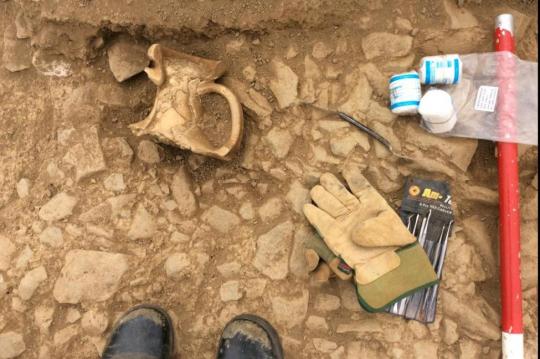
Fragment of an amphora found underneath a Roman road in Devon.
The old hierarchies still existed, now with Roman trappings. The landowners had coloni (tenants who were tied to the land). The trival leaders who owned extensive land and property were at the top; the large community of slaves at the bottom. The word servus (“slave”) eventually became the word “serf”. The social patterns of the Bronze & Iron Ages were still entrenched, now strengthened and deepened by the rule of a strong central power.
The Romans turned the old tribal regions into civitates (government districts). Each district had a central town, often the old tribal capital or oppidum, re-dressed in stone instead of wood. The centre of the town was represented by a forum complex of civic buildings.
Roman architectural forms were imposed, with monumental arches, sculptures, bath-houses and altars (for example). Many of these public buildings were constructed as part of a state initiative that continued well into the 100s AD. There would be a forum, temple, basilica and amphitheatre rising above the smaller buildings – closely-packed houses, workshops and shops, still mostly built out of wood and clay, and with earthen floors. Many of the houses were single-room lodgings; other buildings consisted of a shop at the front, a workshop behind it, and a room for living in at the back. Many wells & hearths have been found in the areas of settlement. Beyond the streets were the kilns, quarries, livestock enclosures and cemeteries.
A curia (council) of the larger landowners controlled the town's government, and they had many clerks and other officials. Kinship and tribal ties slowly transformed into group relations on an economic basis.
The larger towns were independent and self-governing. Magistrates & councillors dealt with things such as drainage, sanitation, and road re-paving. The most common Roman artifact found in England is the writing tablet.
The native elites began to build Roman-style villas in the countryside. The earliest of them (such as the one at Fishbourne, Sussex) were of very high status, probably for Romanized tribal leaders or great officials of the empire. They spread to other native leaders, with more modest villas being built in south-eastern England – appropriate for a wealthy landowner, or the most important family of an agricultural community.

Dolphin mosaic from the Fishbourne villa.
The villas had stone walls and expensive mosaics; there was also underfloor heating and window glass. Their roofs may have been made of ceramic tiles instead of thatch and wattle. Some (most?) of the smaller houses were plastered and decorated with wall paintings (plaster was used as external protection from the elements).
However, hill forts were still important, especially for England's leading families who had stayed closer to their social & cultural traditions.
At the beginning of the 100s AD, in Keston (Kent), an Iron Age farm was still being used. By the middle of the 100s a new wooden farmhouse was built, with painted walls. At the beginning of the 200s a stone house was built, with a Roman-style bath-house. There were wooden barns in the farmhouse, one of which was later rebuilt in stone. Ovens were used for malting or corn-drying, and the owner/s of the villa probably employed potters, blacksmiths and bronze-workers. There was an early Roman cremation cemetery, and a circular mausoleum from a later date. Romanization was gradual.
Bronze & Iron Age practices were kept on in the farming of the soil itself. In some regions (such as the south-west) old practices continued without any change. There is only evidence of change in the south-east, and only among the leaders. The Romans brought in cherries, figs and mulberries (all previously unknown); peas, cabbages and turnips first appeared during the Roman era. Even in the Romanized regions, the natives still preferred beef to pork.
Overall, most people were still living in the Iron Age, and would continue to do so for several centuries.
By imperial decree, the fens of East Anglia were drained, and reclaimed soil was made productive. Hundreds of villages and farms were established in a pre-ordained manner. The region became an imperial estate, with taxes for the central government. The prosperous Salisbury Plain also became an imperial estate.
Taxation included land tax and a poll tax, and it was the key of Roman exploitation. With the northern invaders, the cost of maintaining the army increased, so taxation increased as a result. The old tribal economy was changing to a monetary economy, and the Romans hastened this process. Imperial coinage replaced the old tribal coinage.
The Romans levied taxes on goods that were traded. Industrial centres (e.g. the potteries at the village of Castor in Cambridgeshire) altered parts of the landscape. Ironworks were established in all areas of England, and lead mines were in continuous use during the Roman era. Coal was used for working iron, heating the bath-houses, and the sacred fire at Minerva's temple in Bath.
There were two native woollen products in demand by the English people – the birrus Britannicus (a type of waterproof cloak & hood), and the tapete Britannicum (a woollen rug). The men wore cattle-hide jackets and leather breeches.
Also traded were bears and bulldogs for the Roman arena. It was said that Caesar had invaded England so he could get some exxcellent oysters.
In the early 200s AD, England was divided into two provinces. Brittania Superior's capital was London, and Brittania Inferior had York as its centre. (These were geographical terms, not implying that the former was better than the latter). These two provinces were later subdivided into four provinces, and then into five. The country was being closely administered and exploited.

Provinces in the 200s and 300s AD.
England's role changed as it became a settled part of the empire. The armies of occupation became armies of defence; they became naturalized, and had specific local/regional identities. Over 1/10 of the Roman imperial army was stationed in England, meaning that its forces had a lot of power over events in Rome. Mutinies and uprisings weren't uncommon.
In 268, Carausius (the governor of England) proclaimed himself Emperor, and took his forces to the continent. While he was away, the towns and cities of England took measures to defend themselves against potential reprises from Rome.
A century later, another Roman commander seized the province of England and declared it to be independent. A battle somewhere in central England dealt with this.
England had a lot of significance in imperial calculations, and it was worth a fight. Its taxes, ports and metals helped to sustain Roman commerce. Its agriculture, however, was what made England so wealthy and productive.
In 359 AD, the Emperor Julian organized a fleet of 600 ships to transport English corn to the warzones of the Rhine. England was now one of the “bread baskets” of Europe, and by the 300s AD it had never been so prosperous. The villas became larger and more luxurious, but social stratification increased as well. The Roman English controlled the Iron Age English.
The Scots and Picts were always pressing against the northern borders, but England's other frontiers also developed problems. The Saxon Shore is an alignment of forts in southern England whose purpose is not entirely certain. They may have defended the coast against Saxon invaders from north-west Europe; or they may have harboured Saxon fighters and traders – i.e. designed to protect the seaways between England and Europe.

The Saxon Shore (it had fortifications & military commands on both sides of the Channel).
Christianity was introduced to England in the 100s AD, but it was still a minority religion. The Roman English were now used to the Roman gods, and the Iron Age English probably still worshipped their old gods. Christian vessels & plaques from the 200s have been found in Huntingdonshire, near the River Nene, and are evidence of a local shrine (and the earliest examples of such vessels in Roman Britain). A Christian cemetery, around the same date, was found at Poundbury (Dorset). By the 300s AD, Christianity had spread as far north as Carlisle (in north-west England).
Constantine converted in 312 AD. He had been appointed Emperor at York in 306, and later seems to have considered England to be one of the spiritual centres of his rule. York was refashioned in honour of his elevation, and he visited England three more times. He styled himself on Britannicus Maximus (“The great victor in England”), and London was possibly renamed Augusta in his honour for a while.
Christianity was a monotheistic faith, and the emperor aspired to single rule. It had a uniform set of values & beliefs. It helped to support the legislative & bureaucratic forces of the central power, and the religion's followers were drawn from the governing class. The Romanized English were quick to embrace Christianity, and so Christianity became associated with the culture of the villas. It was also the religion of the administrative elite in the towns and cities, where there would be a bishop to care for the town-dwelling Christians.
In 314, three English bishops, a priest, and a deacon attended an ecclesiastical council in Arles (southern France). The bishops were from York, London and Lincoln, and the priest & deacon were from Cirencester.
At Tower Hill (London), remains of what may have been a Christian cathedral have been found. The building had marble and painted walls, and a holy well in the centre of the nave. This may have been the diocesan centre for Bishop Restitutus of London.
Evidence for a church has been found as Silchester as well, but there is little evidene for other churches during the 200s and 330s. The earliest churches lie beneath more recent ones.
Rome's frontiers were being threatened, and in many places they were overwhelmed. The Franks had entered northern Gaul, and the Visigoths were to settle in Aquitania. The pressure of the Scots & Picts was growing, and they had tribal allies among the Franks and Saxons. In 367, a northern force overcame Hadrian's Wall and moved southwards in dispersed bands to ravage the country. The commander of the Saxon Shore forts was murdered, and the provincial leader known as Dux Britanniarum was captured. Roman intervention and rebuilding helped, including the re-fortification of key posts. But it was a notable defeat for the English, and then the northern tribes came back 40yrs later.
At the beginning of the 400s, England was effectively stripped of its military forces, as they had gone off in search of glory – various pretenders were making bids for imperial power in Rome, weakening Roman rule. Rome's administrative machinery was beginning to break apart.
In England, the northern tribes attacked again in 408, and the Roman English had to defend themselves without the Romans. Zosimus, a contemporary historian, records that they “took up arms and, braving danger for their own independence, freed their cities from the barbarians threatening them.”
Not only that, but according to Zosimus, the English expelled their Roman governors and established their own administration.
Some Roman English would have wanted to retain the Roman administration, as it benefitted them greatly. Others would have wanted to get rid of it, because of taxation and coercion from the central government. In 410, one section of the English asked the Roman Emperor for arms and soldiers (it's unknown whether it was for fighting an external Saxon army, or another group of English). Honorius replied that the English must now fend for themselves – this was the end of Roman England.
Procopius of Caesarea (another historian) records that after the Roman officials disappeared, the cities and regions were taken over by “tyrants” or “usurpers”. They were probably the familiar English leaders, descended from tribal chiefs or large landowning families (but would have seemed like usurpers to Rome).
The English tribes and polities reacted to the end of Roman England in several ways. The Romanized English (in the towns and cities, with dependent estates all around them) probably formed themselves into self-governing administrative units, with the leaders of these small states still known as “magistrates”.
In the east and south-east of England (the civil zone), small kingdoms developed, defended by mercenaries. Those in eastern England had to use Germanic soldiers, which would cause problems for them later on.
In the more distant regions of England, where Romanization had never properly taken hold, the people returned to pre-Roman forms of social organization. The detachments that remained of the northern armies were grouped under a commander who became their chieftain. One of the first Roman leaders of the north was Coelius or Coel Hen, who became “Old King Cole” of the nursery rhyme.
There were general changes overall as well. Rome's taxation system was dismantled, and the countryside was now controlled by an aristocracy of landowners. The circulation of coinage decreased quickly because of the lack of imperial taxation. By 410, the large centres of pottery manufacturing had gone out of business, as the demand no longer existed. Brick-making disappeared, and wouldn't return to England until the 1400s. Villas were neglected or abandoned, and later settlers would use them.
The cities didn't decline, though – they merely changed their function. They were still administrative centres for the immediate area, and the local leader & bishop lived there. However, they didn't need the imperial façades of the 200s. The Silchester basilica was converted into a metal-working centre. There is evidence of rebuilding at York & Gloucester during the 400s. In the second half of the 400s, a new water supply with wooden pipes was introduced to Verulamium. So a civic organization was still in operation.
The Roman city of Wroxeter has been excavated in the fields of Shropshire, and it wasn't abandoned after the Romans left. The basilica was destroyed, and a large wooden hall built in its place – this hall became the centre for a complex of wooden buildings based on Roman models. Well into a medieval period, a prosperous and busy life continued on.
In the archaeologial strata of the 400s is a deposit, called “dark earth”, spread over many towns and cities. This is the residue of wattle-and-daub dwelling. The towns & cities during this century may have still been heavily populated, continuing on a commercial life.
Barter and local trading allowed for self-sufficiency. There was hand-made pottery, and quantities of clay have been found that may have been used for building walls. The farmers' and labourers' lives weren't changed at all by the change in leadership.
St. Patrick was taken by Saxon slavers at the end of the 300s AD, and his Confession of Saint Patrick shows that the affluent lives of villa-owners continued into the early decades of the 400s. He returned to England 6yrs later, and his father urged him to enter public service – for example, local rhetoricians were employed to guide the populace. There was some kind of a working polity based upon a Roman original.
Bishop Germanus of Gaul visited England in 429, and he was greeted by the leading men of Verulamium in a gesture of civic unity. These men were probably members of the diocesan or provincial council who had taken over the city's administration. According to Germanus, they were “conspicuous for their wealth, fashionable in their dress, and surrounded by an adoring multitude of people.”
One of the reasons for Germanus' visit was to help the English in their fight against the Picts and Saxons. However, many Saxons were already living in England, and had been doing so since the 200s AD. The urban & tribal elites needed Saxon warriors to defend their property, and many of these warriors married native women and settled down with their families. The Roman army in the north still had Germanic soldiers in it. There were Saxon traders in the towns and cities; and Saxon workers cultivated the land in Kent in exchange for occasional military service.
From the Iron Age onwards, the native English have been called “Britons”. However, that term is really only correct for the Atlantic English of the western coasts – these are the Britons who would migrate to Gaul and establish the province of Brittany; they spoke Celtic and Gaelic. There were also many Britons in the north, as a remainder of old tribal groupings.
Native English also lived in central, south and east England. However, they lived in the areas that the Saxon settlers would eventually dominate (sometimes peacefully, and sometimes by violent means). The name of England would come from one of these groups of settlers, the Angles. “Engla land” was the Viking description.
#book: the history of england#history#classics#military history#colonialism#economics#trade#architecture#christianity#caesar's invasions of britain#roman conquest of britain#boudicca's uprising#great conspiracy#ancient rome#britain#roman britain#england#atrebates#iceni#scotland#picts#saxons#julius caesar#cassivellaunus#verica#claudius#aulus plautius#caratacus#boudicca#rape tw
8 notes
·
View notes
Text
English History (Part 5): Iron Age
Iron Age (c. 800 – 43 AD)
From the beginning of the Iron Age, relations between the land and people were governed by an advanced concept of territoriality. This concept of territoriality had gained strength over the millennia – leaders & tribes were already firmly associated with specific regions, which can be seen in the boundaries and locations of settlements.
But this all intensified greatly during the Iron Age, and iron played a huge part in it. Gradually, new trade networks and forms of alliance were established. Ritual and ceremonial objects were made out of iron. The iron trade contributed to the eventual shape of England, as the various regions were becoming more intensely organized and controlled.
The hierarchical structure of societies also intensified. There were chieftains and sub-chieftains; warriors and priests; farmers and craftsmen; workers and slaves. Slave irons have been found near St. Albans (Hertfordshire), and a gang chain on Anglesey (an island off the north-west coast of Wales).
Meanwhile, funerary practices for the elite were becoming extremely elaborate. Iron Age chieftains were buried surrounded by molten silver, gold cloth, ivory, iron chainmail suits, and precious cups & bowls. One mortuary chamber was found to have trampled earth around its base, which suggests that people danced there.
Elite women's graves contained many ornaments, including mirrors, brooches and bangles, bowls, beads and tweezers. On woman was buried with a large bronze bowl placed over her face.
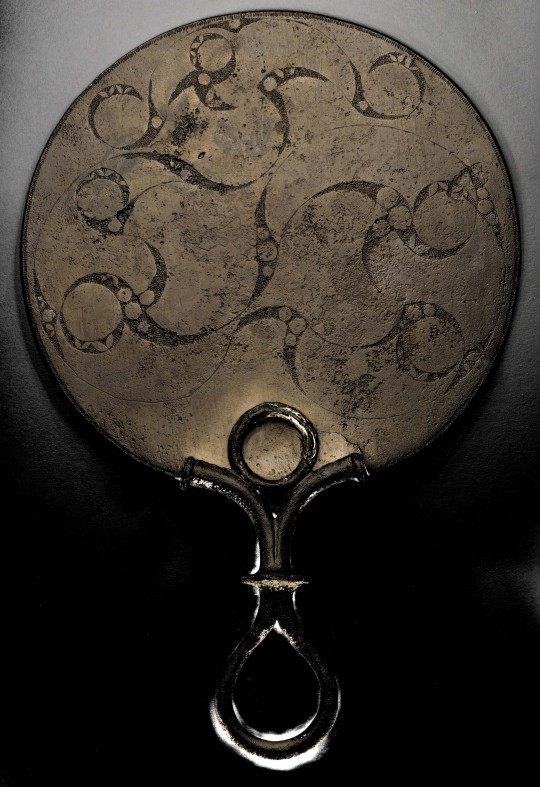
The Oxfordshire Mirror, from the 00s BC.
Because of the increased sense of territoriality, regional identities were strong. This can be seen in the types of settlements in various regions of England:
Eastern England – undefended settlements (similar to villages) among open fields.
South-western England – small communities in defended homesteads, and unenclosed settlements at a distance. This was likely a division between the tribal leaders and the ordinary people.
North-eastern England – defended homesteads.
North-western England – round houses known as “beehive huts”.
Wessex Culture (Salisbury Plain) – a pattern of large territorial groupings based around hill forts.
There are variations upon these themes, such as the pit dwellings carved out of the chalk in Hampshire (a county on the southern coast); and the lake villages of Somerset (south-western England), with round huts built upon floating islands of logs.
The hill forts of Wessex show that this society was strongly hierarchical. They probably originated in the Cotswolds (south-central & south-western England), and then spread over the whole of south-central England. They were a symbol of elite ownership, as they demonstrated the mastery of land and resources.
The territory controlled by each fort was often marked out by linear earthworks that served as boundaries. The forts became more heavily-defended over the Iron Age, and some of them were occupied for centuries.
These hill forts served as towns, not just forts. They had clusters of building and streets, temples and storage facilities, and “zones” for separate industrial activities. The circular houses were made of upright posts, woven together with wattle and sticks of hazel. Their doors & porches faced east. The roofss were usually thatched with reeds or straw, which was held in place with a daub of dung, clay & straw. Soot from the peat fires was a valuable manure, so the dung mixture (and thatch?) was probably replaced each year. The people had small cupboards inside their houses to store weapons in.
The populations of these hill forts were small, from 20 to 200, but they were the beginning of urban English life. It is possible that London was once a hill fort, with its origins buried beneath the modern town.
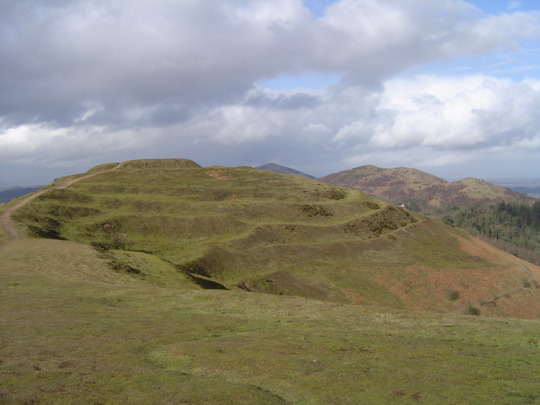
British Camp, an Iron Age hill fort in Hertfordshire.
The many small tribes of this period lived in a state of constant alert against their rivals. There were cattle raids, conflicts between warriors, and even large-scale wars. Some hill forts were stormed and burned; bodies have been found in the ramparts, with their bones marked & hacked.
In this sort of a culture, heroic songs & tales would have been sung & told to celebrate the deeds of individual warriors and/or leaders. Early Irish epics have such tales, perhaps containing stories & refrains from the prehistoric Irish tribes. A comparison with the Iliad can be made.
These tribes & regional groupings did have network alliances and kinship ties, however. Many smaller clans were eventually integrated, and became larger territorial units (perhaps because of danger). These were the English tribes whom the Romans would confront later.
By the end of the Iron Age, some hill forts had become dominant, and took on the role of regional capitals. The population increased steadily, and so agriculture became even more intensive. People continued to clear woodland and forest. The thick clay soils were worked with heavy wheeled ploughs. This was the foundation for the agricultural economy of England. They grew wheat in Somerset and barley in Wiltshire, and they still do today.
In 325 BC, the Greek merchant & explorer Pytheas landed on England's shores. He named the island as Prettanike or Brettaniai, hence why we have the name “Britain” today. He gave the land of the Picts the diminutive name Pryden. He visited Cornwall, and watched people there work and purify the ore.
Pytheas wrote about the people worshipping various Greek gods, but he was simply projecting the Greek names onto the native Celtic gods. The Greeks saw all foreign gods in their own terms.
He wrote of seeing “a wonderful sacred precinct of Apollo and a celebrated temple festooned with many offerings”. This temple was “spherical in shape”. Close by there was a city “sacred to this god” who kings were called “Boreades” [the Greek god of the cold north wind].
Iron Age art (often called Celtic art) was very intricate, with a mastery of artificial form and linearity. It uses spirals and swastikas, curves and circles. Its patterns are related to the whorls, spirals & concentric circles carved upon Mesolithic passage graves several millennia earlier. This suggests a continuity of belief and worship.

The Battersea Shield (c. 350 - 50 BC), a decorative shield facing.
The religion of England was Druidism. There were certain sacred places, including caves and sacred groves. Druids congregated in these sacred groves, with ancient trees creating the setting for ritual practice.
In a barrow in Yorkshire, dating back to the early Bronze Age, drum-shaped idols made of chalk have been found. They have what seem to be human eyes & noses. 2,000 years later, the British writer Gildas (c. 500 – 570 AD) wrote of these “diabolical idols...of which we still see some mouldering away within or without the deserted temples, with the customary stiff and deformed features.” This shows that there was a long tradition of worship that may have had its roots in the Neolithic Period.
The image of the horned god Cernunnons has been found at Cirencester (Gloucestershire), and images of the horse goddess Epona in Wiltshire and Essex. In East Stoke (Nottinghamshire), a carving of the hammer god Sucellus has been found. The mysterious god Lud (or Nud) has his name in Ludgate Hill & Ludgate Circus (London).
There were religious sanctuaries all over the land, and even the smallest settlements probably had their own central shrines. They have been found in hill forts, within ditched enclosures, along boundaries, and above barrow graves. Often, Roman temples or early Christian churches were built atop them.
During the Iron Age, it was believed that the rooster served as a defence against thunderstorms. This is why we have weathercocks on church steeples.
Human sacrifice was practised, probably in order to sanctify the land. One man was bludgeoned to death and had his throat cut before being deposited in the marsh in Cheshire (north-western England). In southern England, many skeletons have been found in the bottom of bits, flexed into unnatural positions.
Severed heads, probably believed to be the site of the soul/spirit, were also important. Skulls have been found lined up in a row. Often the bodies of defeated enemies were beheaded, and their heads either buried or placed in running water. 300 skulls have been found in the Thames, dating from the Neolithic Period to the Iron Age.
According to Caesar, the Druids (high priests) created images of wicker-work, which they “fill with living men and, setting them on fire, the men are destroyed by the flames.” The Druid priests were the lawmakers of the land – they determined rewards & punishments; and settled disputes over boundaries & property.
Pliny wrote that the Druids “esteem nothing more sacred than the mistletoe”. The high priests “select groves of oak, and use the leaves of the mistletoe in all sacred rites.” They tied the sacrificial victim to an oak tree, and the killers wore chaplets (garlands/circlets worn on the head) made of oak leaves.
The Druids practised divination, astrology and magic. They believed that the soul was immortal, and was reincarnated. The Roman writers considered this belief to make clear the native English contempt for death.
The Druids worshipped the sun and moon, and this solar belief persisted even after their demise. In 1452, a butcher from Standon (Hertfordshire) was accused of proclaiming that there was no god except for the sun and moon. The Druids' power was retained by the Anglo-Saxon bishops, and the tonsures of early Christian monks may also have originated with the Druids. Thomas Hardy, in Tess of the d'Ubervilles, notes that “old customs” last longer on clay soils.
By 100 BC, there were 15 large tribes in England, and they were coming under the control of leaders who were now being called kings. In the years before the main Roman invasion, Suetonius named Cunobelis (leader of the Catuvellauni) as “rex Britannorum”. Cunobelis' capital was St. Albans (Hertfordshire, southern England), and he controlled a large area north of the Thames, including Cambridgeshire, Bedfordshire and Oxfordshire. The Catuvellauni were a fully-formed elite culture of warriors and priests, and its traditions went back to the early Bronze Age. Cunobelis is the Cymbeline of Shakespeare's play of the same name.

Territory of the Catuvellauni.

Territories of southern Britain’s Celtic tribes.
At some time during the 400s BC, members of the Parisii (a tribe from northern Gaul) settled in Yorkshire, where they created an archaeologically distinctive community. During the 00s BC, a tribe called the Belgae launched a small invasion, and eventually settled in Hampshire, Essex and Kent. The Roman name for Winchester was Venta Belgarum, meaning “the market of the Belgae”.
England's population during the late Iron Age was about 2 million, and by the time the Romans left, it would be 3 million. It was a flourishing, wealthy country, with a surplus of corn, which was why the Romans wanted to invade it.
The south of England was particularly well-off. In south-eastern and central southern England, there was a spread of settlements with extensive towns & villages, markets, industries, shrines, cemeteries and fields. Julius Caesar stated that “the population is very large, their homesteads thick on the ground and very much like those in Gaul, and the cattle numerous. As money they use either bronze or gold coins or iron bars with a fixed standard of weight.” The coins had the stamp of powerful leaders, and made trade easier between tribes.
The further north you went, the less there was of all this. This was because the southern tribes had been trading extensively with Rome and Romanized Gaul long before the Roman invasion. They loved certain foods and luxury goods, and were Romanized to a fair extent.
But they still had their ancient tribal ways as well. There was consistent warfare between tribes, and various leaders appealed to Rome for assistance. Large earthworks were built as boundaries. The warriors rode chariots to battle, and were naked, covering their bodies with blue woad, and having pierced tattoos. Caesar wrote: “They wear their hair long, and shave all their bodies with the exception of their heads and their upper lips.”
#book: the history of england#history#prehistory#classics#trade#economics#art#art history#bronze age#iron age#britain#ancient rome#prehistoric britain#iron age britain#bronze age britain#roman britain#england#wales#wessex culture#catuvellauni#parisii#belgae#hampshire#somerset#yorkshire#druidism#pytheas#julius caesar
30 notes
·
View notes
Text
Siberian History (Part 7): Mangazeya
The Russian frontiersmen in Siberia still had to depend on Moscow for support (such as administrative & logistical support). During the Time of Troubles, the Siberian garrison was mostly left to themselves, which lead to disease, starvation and death.
The natives peoples of Siberia took the opportunity to make several attempts at an uprising. The most powerful was in 1608, when Princess Anna of Koda, a “Tartar Joan of Arc”, nearly succeeded in uniting the entire native population of Western Siberia to revolt.
In 1612, an attempt was made to re-establish the old Khanate of Sibir “as it had been in the time of Kuchum”. But it was betrayed at the last minute, and ten of its ringleaders were rounded up and hanged.
By now, the Russian occupation of the Ob-Irtysh Basin had increased the nation's size by a third. But in Moscow, Siberia still wasn't properly understood as a geographical entity, and so it was used as a political bargaining chip.
Boris Godunov, for example, tried get an influential boyar to support him against False Dmitry I, by promisng him “the Kingdoms of Kazan, Astrakhan, and all Siberia”. The False Dmitry II promised to reward his brother-in-law, a powerful Polish noble, with “the whole land of Siberia” for his help.
But the Ob-Irtysh Basin had scarcely been secured before the Russian advance into the next great river valley, the Yenisei, began.


The Russians ascended the eastern tributaries of the Ob River, and crossed a low plateau to streams flowing into the Yenisei. By 1619, they had taken all the important river routes and portages that connected those two rivers. They organized expeditions from Mangazeya (in the north) and Tomsk & Ketsk (in the south), coming at the river valley from both directions.

The Taz Estuary marks the area where Mangazeya was located.
They met the Tungu people on the lower Yenisei, and the Buryats (whom they'd never heard of before) on the upper Yenisei. The Buryats lived in a region that was rich in furs, and they practised animal husbandry; they were rumoured to grow crops and have access to silver. This was guaranteed to interest Russia.
The Tungu people (east of the Yenisei) and the Buryats (around Lake Baikal) fought to prevent Russia from establishing bases in their territory, but failed. Yeniseysk was founded in 1619 (where the Angara and Yenisei Rivers meet); Krasnoyarsk was founded in 1627 (astride cliffs of red-coloured marl); and Bratsk was founded in 1631 (on the Angara River).


On the upper Yenisei River (the southern part of it), the Russians met the staunch resistance of the Kyrgyz people and the Kalmuks, both steppe nomads. Their homelands bordered Siberia to the south, and they were continually hostile. Eventually, a solidly-fortified line was established over the southern frontier, but this would take two centuries.
Meanwhile, Russian mariners had developed the sea route north of Russia from Arkhangel to Mangazeya (which was just a few miles above the Arctic Circle). At Mangazeya, they bartered goods with the local Khanty and Samoyedic peoples for furs. Mangazeya prospered and grew, attracting more and more traders, who were willing to navigate the treacherous waters of the Kara Sea.
One contemporary account says that: “Hundreds of thousands of sable, ermine, silver and blue fox skins, and countless tons of precious mammoth and walrus ivory” were shipped every year from Mangazeya and Europe. This was an illicit trade that had begun during the Time of Troubles, and the government couldn't manage to gain control of it.
Porcelain, silk, and other expensive fabrics were traded (through middlemen) from Central Asia & China to Mangazeya. The city was “a virtual Baghdad of Siberia, where big commercial deals were celebrated at fabulous feasts that lasted for days, and that featured the best European wines and local delicacies like sturgeon, caviar, mushrooms, berries, and venison and other game.”
By the time stability was restored in Moscow, reports of Siberia's vast wealth in furs had spread far and wide. This, of course, attracted the attention and greed of European powers who wanted new colonies. The Russian government worried that foreign agents might try to trade directly with the natives, or even attempt an armed invasion (through the Taz Estuary) to seize the whole of north-western Siberia.
Meanwhile, inland merchants working out of the Urals, Tyumen and Tobolsk were envious of Mangazeya, as it siphoned off commerce that would otherwise have come to them.
So in 1619, the Russian government closed the sea route to Mangazeya. They forbade even Russians to use it, in case foreigners found it out from them. Anyone who broke this law was to be “put to the hardest possible death, and all their homes and families destroyed branch and root”.
Navigational markings were torn up. Surveillance posts were established along the coast, to intercept and kill anyone who tried to get through. A coastal fort was built on the Yamal Peninsula, commanding the portage between the Ob Gulf and the Kara Sea. Maps were falsified to depict Novaya Zemlya as a peninsula, rather than an island. This would cause problems for later mariners who were using them as nautical guides.
Gradually, Mangazeya declined, and the rich merchants left. In 1643, its administrative apparatus was moved to Turukhansk – this city was founded at the mouth of the Turukhan River, a tributary of the Yenisei. For a while, it was known as “New Mangazeya”.
In 1678, Mangazeya was burned to the ground, without any official explanation. The local Samoyedic peoples called its ruins Tagarevyhard, which means “destroyed town”. The site wouldn't be rediscovered for almost three centuries.
Mangazeya, perhaps more than any other early settlement, was the proof of the enormous wealth that Siberia possessed. In 1632, a former military governor of the district strongly encouraged the tsar to press on from the Yenisei to conquer the Lena River Basin. His encouragement was inspired by the riches of Mangazeya.
#book: east of the sun#history#military history#colonialism#economics#trade#native siberians#tungu people#buryats#kyrgyz people#kalmuks#khanty people#russia#khanate of sibir#siberia#yeniseysk#krasnoyarsk#bratsk#mangazeya#turukhansk#boris godunov#false dmitry ii
36 notes
·
View notes